


1982
Act
Information
Official
the
under
New Zealand Transport Agency
Whirokino Trestle and Manawatu River Bridge Replacement
Released
Post Construction Road Safety Audit
July 2021
1982
Act
Information
Official
the
under
Released
Table of Contents
1.
Background.................................................................................................................. 2
1.1
Saf ety Audit Procedure ......................................................................................... 2
1.2
The Saf ety Audit Team ......................................................................................... 3
1.3
Report Format ..................................................................................................... 3
1.4
Scope of Audit ..................................................................................................... 4
1982
1.5
Documents Provided ............................................................................................ 5
1.6
Disclaimer ........................................................................................................... 5
1.7
Project Description ............................................................................................... 5
Act
1.8
Previous Audit Findings......................................................................................... 6
2.
Saf ety Audit Findings ..................................................................................................... 8
2.1
Barriers .............................................................................................................. 8
2.2
Bridge shoulders ................................................................................................ 15
2.3
Signs................................................................................................................ 18
2.4
Line-marking and delineation ............................................................................... 24
2.5
Miscellaneous.................................................................................................... 28
Information
2.6
Maintenance comments ...................................................................................... 31
3.
Audit Statement .......................................................................................................... 34
Official
the
under
Released
GHD | Report for New Zealand Transport Agency - Whirokino Trestle and Manawatu River Bridge Replacement Post
Construction Road Safety Audit, 125/09290/00 | i
1.
Background
1.1
Safety Audit Procedure
This report has been prepared for the newly constructed Whirokino Trestle and Manawatu
Bridge on SH1 in the Horowhenua District between the towns of Foxton and Levin.
A road safety audit is a term used internationally to describe an independent review of a future
or recently completed project which interact with the road environment to identify any safety
concerns that may affect the safety performance. The audit team considers the safety of all 1982
road users and qualitatively reports on road safety issues or opportunities for safety
improvement.
Act
A road safety audit is therefore a f ormal examination of a road project, or any type of project
which af fects road users (including cyclists, pedestrians, mobility impaired etc.), undertaken by
an independent competent team who identify and document road safety concerns.
A road safety audit is intended to help deliver a safe road system and is not a review of
compliance with standards.
The primary objective of a road safety audit is to deliver a project that achieves an outcome
consistent with Safer Journeys and the Safe System approach, that is, minimisation of death
and serious injury. The road safety audit is a safety review used to identify all areas of a project
that are inconsistent with a safe system and bring those concerns to the attention of the client in
Information
order that the client can make a value judgement as to appropriate action(s) based on the risk
guidance provided by the safety audit team.
The key objective of a road safety audit is summarised as:
To deliver completed projects that contribute towards a safe road system that is increasingly
free of death and serious injury by identifying and ranking potential safety concerns for all road
Official
users and others affected by a road project.
A road safety audit should desirably be undertaken at project milestones such as:
Concept Stage (part of Business Case);
the
Scheme or Preliminary Design Stage (part of Pre-Implementation);
Detailed Design Stage (Pre-implementation / Implementation); and
Pre-Opening / Post-Construction Stage (Implementation / Post-Implementation).
under
A road safety audit is not intended as a technical or financial audit and does not substitute for a
design check on standards or guidelines. Any recommended treatment of an identified safety
concern is intended to be indicative only, and to focus the designer on the type of improvements
that might be appropriate. It is not intended to be prescriptive and other ways of improving the
road safety or operational problems identified should also be considered.
In accordance with the procedures set down in the “NZTA Road Safety Audit Procedures for
Projects Guideline, (Interim Release May 2013)”, the audit report should be submitted to the
client who will instruct the designer to respond. The designer should consider the report and
Released
comment to the client on each of any concerns identified, including their cost implications where
appropriate, and make a recommendation to either accept or reject the audit report
recommendation.
For each audit team recommendation that is accepted, the client shall make the final decision
and brief the designer to make the necessary changes and/or additions. As a result of this
2 |
GHD | Report for New Zealand Transport Agency - Whirokino Trestle and Manawatu River Bridge Replacement Post
Construction Road Safety Audit, 125/09290/00
link to page 6
instruction the designer shall action the approved amendments. The client may involve a safety
engineer to provide commentary to aid with the decision.
Decision tracking is an important part of the road safety audit process. A decision tracking table
is embedded into the report format at the end of each set of recommendations to be completed
by the designer, safety engineer and client for each issue documenting the designer response,
client decision (and asset manager’s comments in the case where the client and asset manager
are not one and the same) and action taken.
A copy of the report including the designer’s response to the client and the client’s decision on
each recommendation shall be given to the road safety audit team leader as part of the
important feedback loop. The road safety audit team leader will disseminate this to team
members.
1.2
The Safety Audit Team
The road safety audit was carried out in accordance with the “NZTA Road Safety Audit
Procedures for Projects Guideline”, (Interim Release May 2013) and also reference made to its
earlier document (dated 2004).
The assessment team was as follows:
s 9(2)(a)
GHD Limited, Wellington - Auditor
s 9(2)(a)
GHD Limited, Wellington - Auditor
s 9(2)(a)
GHD Limited, Wellington - Barrier inspection
s 9(2)(a)
GHD Limited, Wellington - Observer
Members of the Safety Audit Team (SAT) undertook a daylight site inspection on 11th February
2020 and an evening and darkness site inspection on the 25th February 2020 prior to traffic
being shifted onto the new road sections.
1.3
Report Format
The potential road safety problems identified have been ranked as follows:-
The expected crash frequency is qualitatively assessed on the basis of expected exposure (how
many road users will be exposed to a safety issue) and the likelihood of a crash resulting from
the presence of the issue. The severity of a crash outcome is qualitatively assessed on the
basis of factors such as expected speeds, type of collision, and type of vehicle involved.
Ref erence to historic crash rates or other research for similar elements of projects, or projects
under the Official Information Act 1982
as a whole; have been drawn on where appropriate to assist in understanding the likely crash
types, frequency and likely severity that may result from a particular concern.
The f requency and severity ratings are used together to develop a combined qualitative ranking
f or each safety issue using the Concern Assessment Rating Matrix i
n Table 1 below. The
qualitative assessment requires professional judgement and a wide range of experience in
projects of all sizes and locations.
Released
GHD | Report for New Zealand Transport Agency - Whirokino Trestle and Manawatu River Bridge Replacement Post
Construction Road Safety Audit, 125/09290/00 | 3
link to page 6
Table 1: Concern Assessment Rating Matrix
Severity
Frequency (probability of a crash)
(likelihood of death or
serious injury)
Frequent
Common
Occasional
Infrequent
Very likely
Serious
Serious
Significant
Moderate
Likely
Serious
Significant
Moderate
Moderate
Unlikely
Significant
Moderate
Minor
Minor 1982
Very unlikely
Moderate
Minor
Minor
Minor
Act
While all saf ety concerns should be considered for action, the client or nominated project
manager will make the decision as to what course of action will be adopted based on the
guidance given in this ranking process with consideration to factors other than safety alone. As
a guide a suggested action for each concern category is given i
n Table 2 below.
Table 2: Risk Categories
Concern
Suggest Action
Serious
A major safety concern that must be addressed and requires changes to
avoid serious safety consequence
Information
Significant
Significant concern that should be addressed and requires changes to
avoid serious safety consequences
Moderate
Moderate concern that should be addressed to improve safety
Minor
Minor concern that should be addressed where practical to improve safety
In addition to the ranked safety issues it is appropriate for the safety audit team to provide
Official
additional comments with respect to items that may have a safety implication but lie outside the
scope of the safety audit. A comment may include items where the safety implications are not
yet clear due to insufficient detail for the stage of project, items outside the scope of the audit
the
such as existing issues not impacted by the project or an opportunity for improved safety but not
necessarily linked to the project itself. While typically comments do not require a specific
recommendation, in some instances suggestions may be given by the auditors.
1.4
Scope of Audit
under
This audit is a Post Construction (Pre-Opening) Stage Safety Audit of Whirokino Trestle and
Manawatu River Bridge Replacement. This audit includes all works completed prior to the
shif ting of traffic onto the new alignment. Elements not audited include:
Cycle-path
Link Road
Whirokino Road intersection
Released
The SAT has a copy of the preliminary design safety audit completed in December 2014, a
specimen design safety audit completed in May 2016, and February 2018.
4 |
GHD | Report for New Zealand Transport Agency - Whirokino Trestle and Manawatu River Bridge Replacement Post
Construction Road Safety Audit, 125/09290/00
link to page 8
1.5
Documents Provided
The SAT has been provided with the following documents for this audit:
Whirokino Trestle and Manawatu River Bridge, 142220/07, Bloxam Burnett & Oliver, 28
July 2016, drawings 5001, 5201-5204, 5221, 5223 and 5224, 5351-5356, and 5361.
Whirokino Trestle and Manawatu River Bridge Preliminary Design Safety Audit Report,
GHD Limited, December 2014.
Whirokino Trestle and Manawatu River Bridge Specimen Design Safety Audit Report,
GHD Limited, May 2016.
1982
Whirokino Trestle and Manawatu River Bridge Median Barrier Safety Audit Report, GHD
Limited, February 2018.
Act
1.6
Disclaimer
The f indings and recommendations in this report are based on an examination of available
relevant plans, the specified road and its environs, and the opinions of the SAT. However, it
must be recognised that eliminating safety concerns cannot be guaranteed since no road can
be regarded as absolutely safe and no warranty is implied that all safety issues have been
identified in this report. Safety audits do not constitute a design review or an assessment of
standards with respect to engineering or planning documents.
Information
Readers are urged to seek specific technical advice on matters raised and not rely solely on the
report.
While every ef fort has been made to ensure the accuracy of the report, it is made available on
the basis that anyone relying on it does so at their own risk without any liability to the safety
audit team or their organisations. Official
1.7
Project Description
The existing Whirokino Trestle and Manawatu Bridge on SH1 between Foxton and Levin
requires replacement. Previous audits have been completed on the design without a median
the
barrier on the bridge and associated widening of the embankment shoulders. This audit will
exclusively focus on changes to the design as a result of the inclusion of a median barrier and
associated widening.
Figure 1 f rom the specimen design shows the existing and proposed replacement alignments
under
and surrounding environment.
Throughout this report references to locations have been provided based on the SH1
southbound running distance from Culvert 9651 (at approximately Reference Station 954, Route
Position 11.0), as per the drawings. For Whirokino Road and Link Road the running distance is
f rom the intersection with SH1, and for Matakarapa Road the running distance is from Link
Road.
Released
GHD | Report for New Zealand Transport Agency - Whirokino Trestle and Manawatu River Bridge Replacement Post
Construction Road Safety Audit, 125/09290/00 | 5
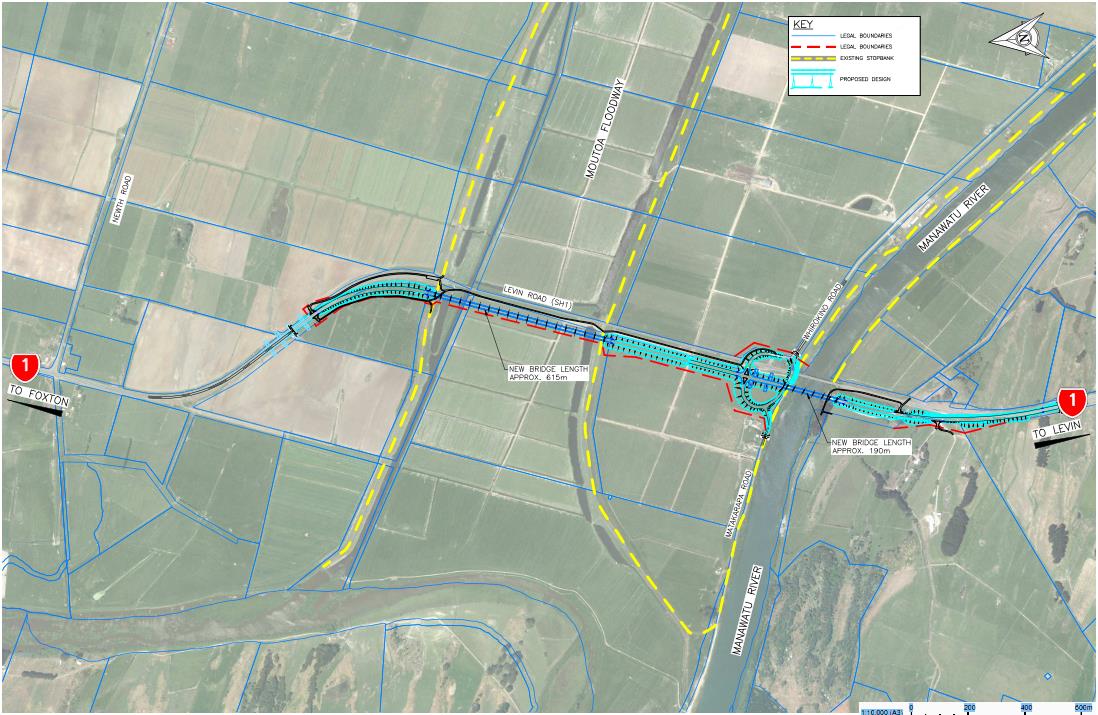
1982
Act
Figure 1: Project Elements and Road Layout (Drawing 5002)
Information
1.8
Previous Audit Findings
Below is a list of findings from the previous median barrier design safety audit.
Issue
Concern Level
Outcome
Official
2.1.1 Rest area right turning
Significant
Only signpost rest area access for
southbound traffic.
2.1.2 Shoulder width at
Moderate
Retain shoulder width.
the
Whirokino Road
2.2.1 Directional signs at
Minor
To be rationalised if an issue in
SH1 intersection
construction.
under
2.2.2 No right turn sign
Minor
Remove no right turn signs from
highway approaches to intersection.
2.2.3 Long yellow no-
Comment
N/A
overtaking advanced
warning lines
2.2.4 Oversized Load
Comment
N/A
Staging Area
Released
Issues identified in the specimen design audit:
1. Typical Section Issues
1.1. Solid White Centreline Marking
SIGNIFICANT
6 |
GHD | Report for New Zealand Transport Agency - Whirokino Trestle and Manawatu River Bridge Replacement Post
Construction Road Safety Audit, 125/09290/00
1.2. Shoulder Width Consistency
MODERATE
1.3. Edge Marker Post Location
MINOR
1.4. Audio Tactile Profiled Markings on Bridges
MINOR
1.5. Bridge Delineation
COMMENT
1.6. Local Road Shoulder/Berm Layers
COMMENT
2. Specific Location Issues on SH1
2.1. Right Turns at Intersections
SERIOUS
1982
2.2. Farm Access at 2400 m
SERIOUS
2.3. Rest Area and Wetland Access at 2275 m
SIGNIFICANT
2.4. Cyclist Permanent Warning Signs
MODERATE Act
2.5. Warning and Directional Sign Frequency
MINOR
2.6. Northern Curve Super-elevation
COMMENT
2.7. Passing Lane Length
COMMENT
3. Local Road Issues
3.1. Whirokino Road Curve at 200 m
MODERATE
3.2. Local Road Embankment Hazard Protection
MODERATE
Information
3.3. Cyclist Warning Signs
MODERATE
3.4. Whirokino Road and Link Road Intersection
MINOR
3.5. Link Road SH1 Bridge Underpass Drainage
COMMENT
3.6. Local Road Directional/Guide Signage
COMMENT
4. Cyclist and Shared Path Issues
Official
4.1. Directional Guidance for Northbound Cyclists onto the Shared Path
SIGNIFICANT
the
4.2. Northbound Shared Path Bridge Clearance
MODERATE
4.3. Shared Path Northern Directional Guidance
MODERATE
4.4. Shared Path Central Stopbank Crossing
MODERATE
4.5. Shared Path Farm Gate
MODERATE
under
4.6. Shared Path Curves
MINOR
4.7. Shared Path Vehicle Exclusion
MINOR
4.8. Shared Path Southern Terminus
MINOR
4.9. Shared Path Maintenance
COMMENT
5. Other Comments
Released 5.1. Drawing Labels COMMENT
5.2. Drawing Ambiguities
COMMENT
GHD | Report for New Zealand Transport Agency - Whirokino Trestle and Manawatu River Bridge Replacement Post
Construction Road Safety Audit, 125/09290/00 | 7
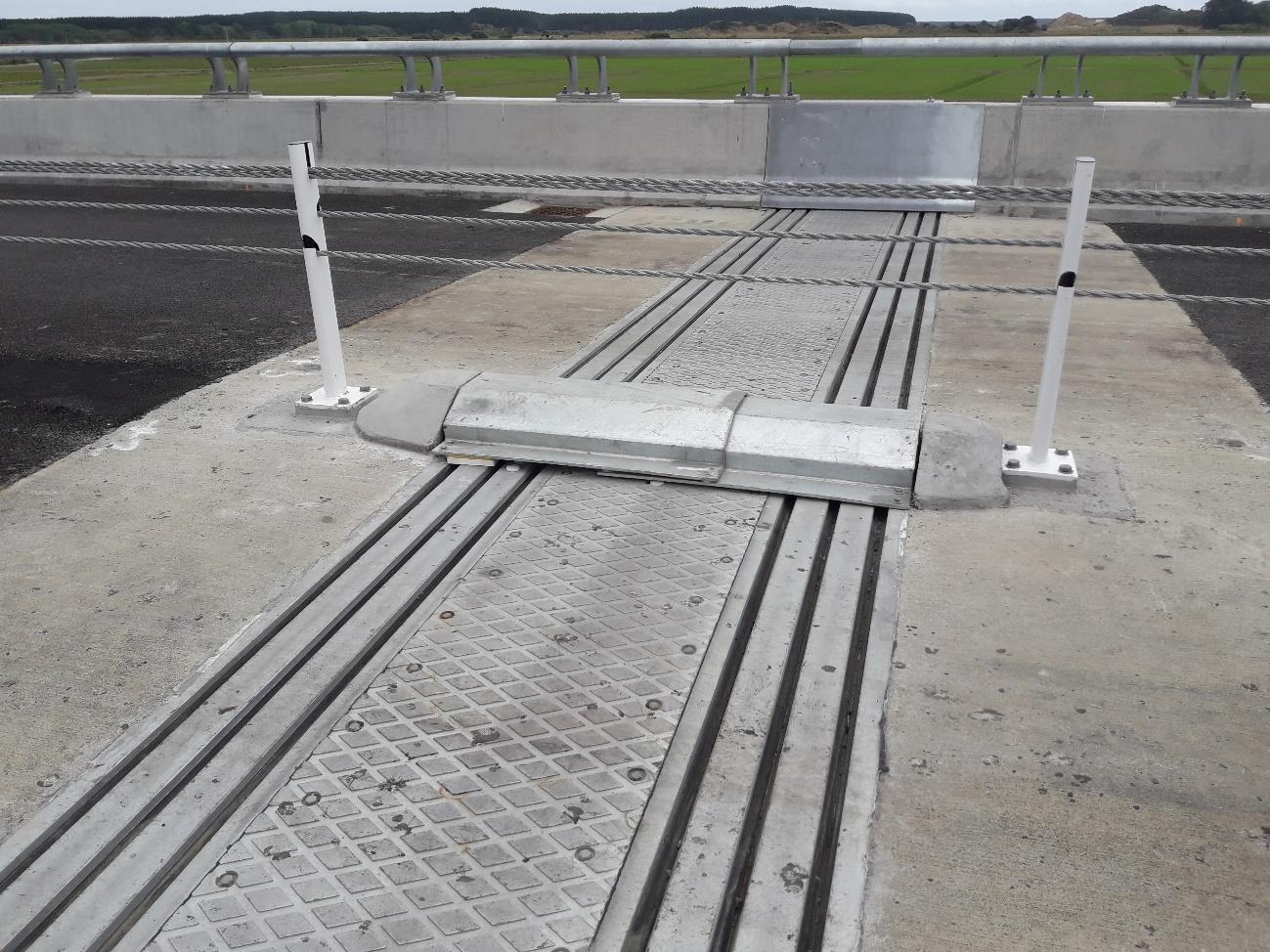 2.
Safety Audit Findings
2.1
Barriers
2.1.1
Mountable kerb height at bridge expansion joints
MODERATE
2.
Safety Audit Findings
2.1
Barriers
2.1.1
Mountable kerb height at bridge expansion joints
MODERATE
Frequency Rating
INFREQUENT
Severity Rating
LIKELY
The mountable kerb will raise the height at which vehicles hit the median barrier, effectively
reducing the height of the barrier. Vehicles should not strike a wire-rope barrier 50 mm below
1982
design height, as it will not perform to manufacturer’s specifications, potentially causing wheel
stags, overturning, etc. Impacts into wire-rope barriers redirect vehicles along the path of the
barrier which reduces the impact severity, potential y allowing the vehicle to regain control and
Act
saf ely come to a stop or re-join the carriageway. With this device in place (Expansion joint cover
and kerbing) effectively creating an abrupt obstacle within the path of the vehicle there’s a high
possibility that this will cause a significant accident.
Information
Official
the
under
Recommendation
Develop options that allow for vehicles to strike the barrier at the correct height. This could
include extending and widening the mountable kerb and placing support post on top of the
Released
mountable kerb, or removing the need for a mountable kerb or cover.
Designer Response
Novare: The mountable barriers and cover plates provide protection to
the joint upstand beneath. It is proposed that WRSB barrier posts
adjacent to the mountable kerb are raised locally to meet minimum
8 |
GHD | Report for New Zealand Transport Agency - Whirokino Trestle and Manawatu River Bridge Replacement Post
Construction Road Safety Audit, 125/09290/00
height requirements and transition to the general WRSB height each
side of the joint.
BBO: AUSTROADS guidance which suggests WRSB height should be
set relative to the top of kerb applies to the situation where the ground
behind the kerb is at the same height as the kerb. In this case, the
vehicle suspension will retract when the wheel hits the kerb, and the
vehicle will engage with the barrier at the correct height. By the time
the suspension extends the vehicle will be well engaged in the barrier
and the wheels will likely be back over the road behind the kerb. Any
changes to barrier height could reduce rather than improve the
1982
perf ormance of the barrier. Propose no change be made.
Saf ety Engineer
Checking in with the Austroads Guide and referencing internal experts,
Act
the BBO recommendation that the suspension will compress is what
would be expected, and the barrier will perform as designed.
Considering the overall length of the barrier and the relativity short
length of mountable kerb, the risk is low that it will be struck and if
struck the risk will be low that the system will fail.
Client Decision
Agree with BBO and Safety Engineer’s responses. No further action
required.
Action Taken
N/A
Information
2.1.2
Mountable kerb at bridge expansion joints
MODERATE
Frequency Rating
INFREQUENT
Severity Rating
LIKELY
Official
The mountable kerb (concrete nose and metal side covering) at the expansion joint is a hazard.
Impacts to the kerb nose (particularly when adjusted for barrier posts) and sides by errant
motorcyclists or vehicles could cause harm, however infrequent they may be.
the
under
Released
GHD | Report for New Zealand Transport Agency - Whirokino Trestle and Manawatu River Bridge Replacement Post
Construction Road Safety Audit, 125/09290/00 | 9
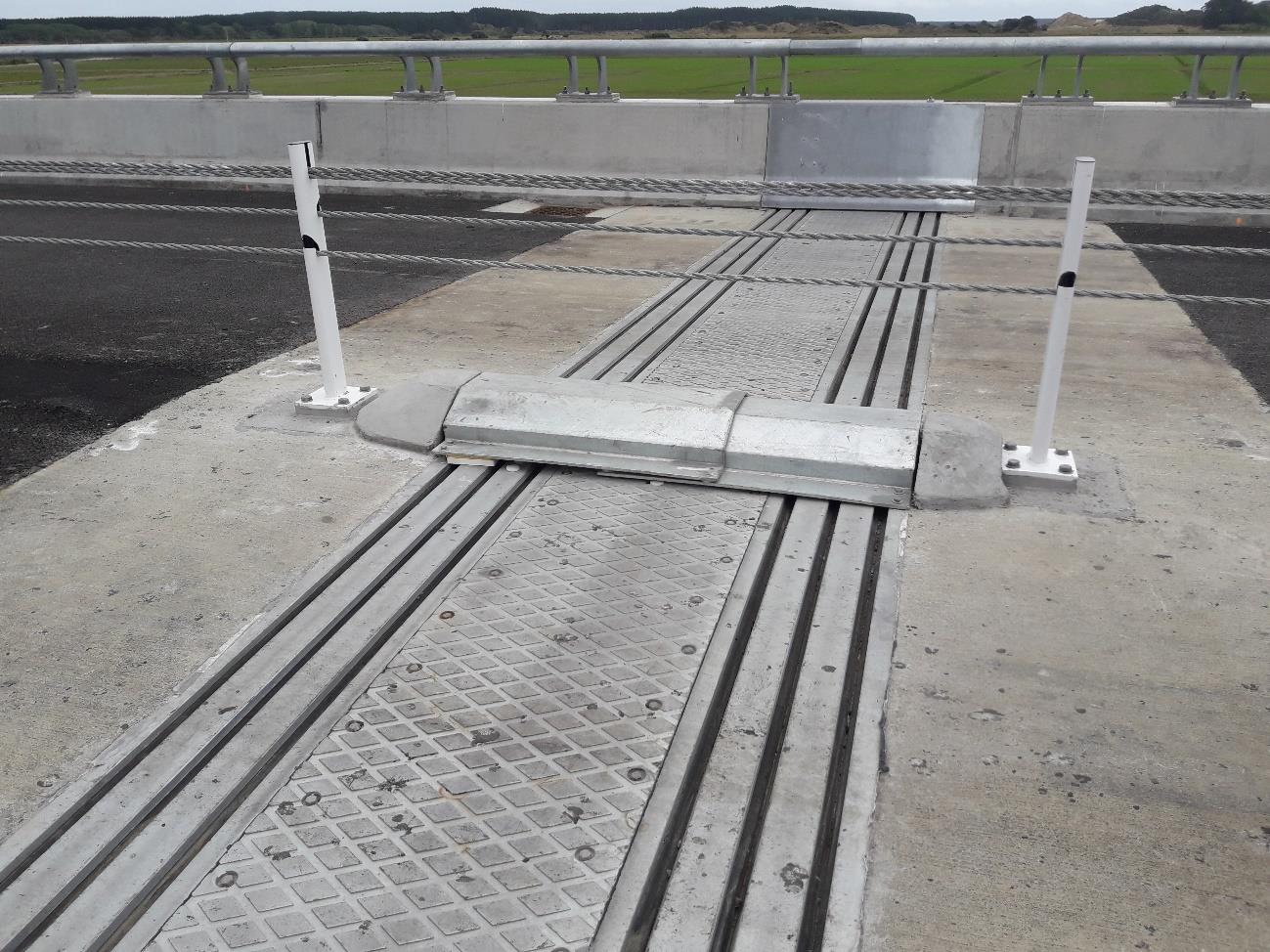

1982
Act
Information
Recommendation
Consider developing options that remove the need for a mountable kerb or cover.
Designer Response
Novare: The cover plates are provided to mitigate the safety hazard
Official
caused by the upstands in the expansion joint as shown in the sketch
below. The mountable kerb is provided to mitigate the hazard further.
The kerb or plate cannot be removed as it will create a f urther safety
the
issue.
under
The length of the mountable kerb can be increased along road
centreline to increase the transition length of the mountable kerb and
mitigate the impact risk.
Released
BBO: Extending the mountable kerb nose will require relocation of the
barrier posts. As discussed in 2.1.1 above, the existing system should
perf orm adequately when impacted by cars. For motorcycles to hit the
kerb they will already have impacted the WRSB so outcomes will
already be severe. Propose no change be made.
10 |
GHD | Report for New Zealand Transport Agency - Whirokino Trestle and Manawatu River Bridge Replacement Post
Construction Road Safety Audit, 125/09290/00
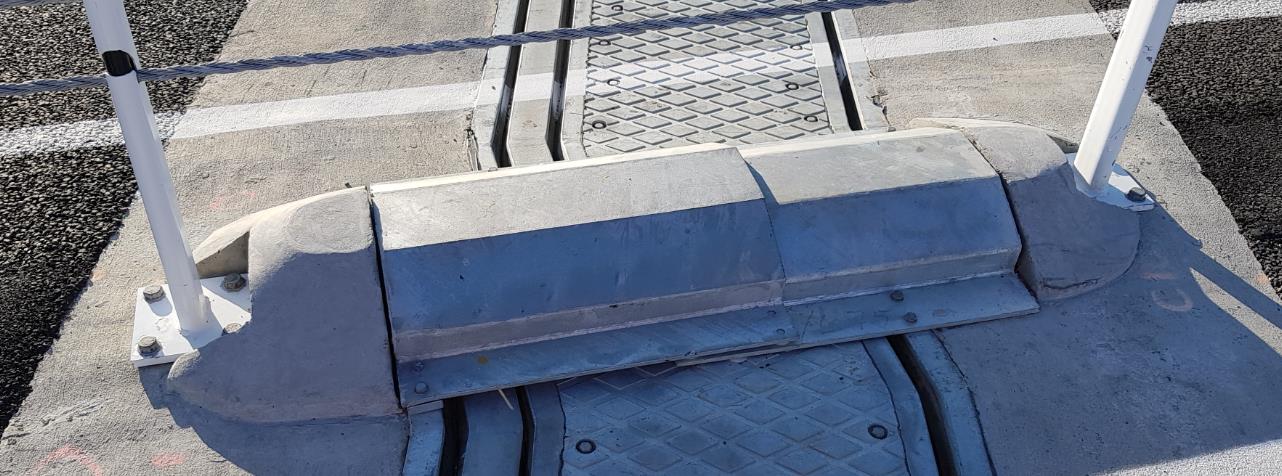
Saf ety Engineer
Considering the overall length of the barrier and the relativity short
length of mountable kerb, the risk is low that it will be struck and if
struck the risk will be low that the system will fail.
Client Decision
Agree with BBO and Safety Engineer’s responses. No further action
required.
Action Taken
N/A
1982
2.1.3
Barrier shear posts immediately adjacent to mountable kerb
MINOR
Act
Frequency Rating
INFREQUENT
Severity Rating
UNLIKELY
Wire-rope barrier posts are placed within or immediately adjacent to mountable kerb. It is
unclear if these posts are designed to shear or their bolt-connection with the bridge will shear on
impact. This may result in performance different to manufacturer’s specifications. Impacts into
wire-rope barrier are redirected along the path of the barrier and so vehicles impacting the
barrier prior to the mountable kerb will be directed into striking them.
Information
Official
the
Recommendation
Designer to confirm that NZTA has accepted the use of the shear-posts at this location.
Designer Response
Novare: The use of shear posts along the centreline is more generally
under approved through the acceptance of the design. Location specific
approval is not noted. Depending on the solution reached for items
2.1.1 & 2.1.2 that may solve this issue. Otherwise, they can be moved
away f rom the mountable kerb and reinstalled with a mechanical
anchor closer to the edge of the expansion joint concrete apron.
BBO: WRSB posts are designed to yield and fold over (in the direction
of travel) rather than shear off, in which case the posts will stil perform
Released
that way mounted where they are. Propose no change be made.
Saf ety Engineer
BBO’s comments address the issue as they are not shear posts; rather
their f rangibility comes from a bending/folding action. Issue is cleared
up and no change proposed.
GHD | Report for New Zealand Transport Agency - Whirokino Trestle and Manawatu River Bridge Replacement Post
Construction Road Safety Audit, 125/09290/00 | 11
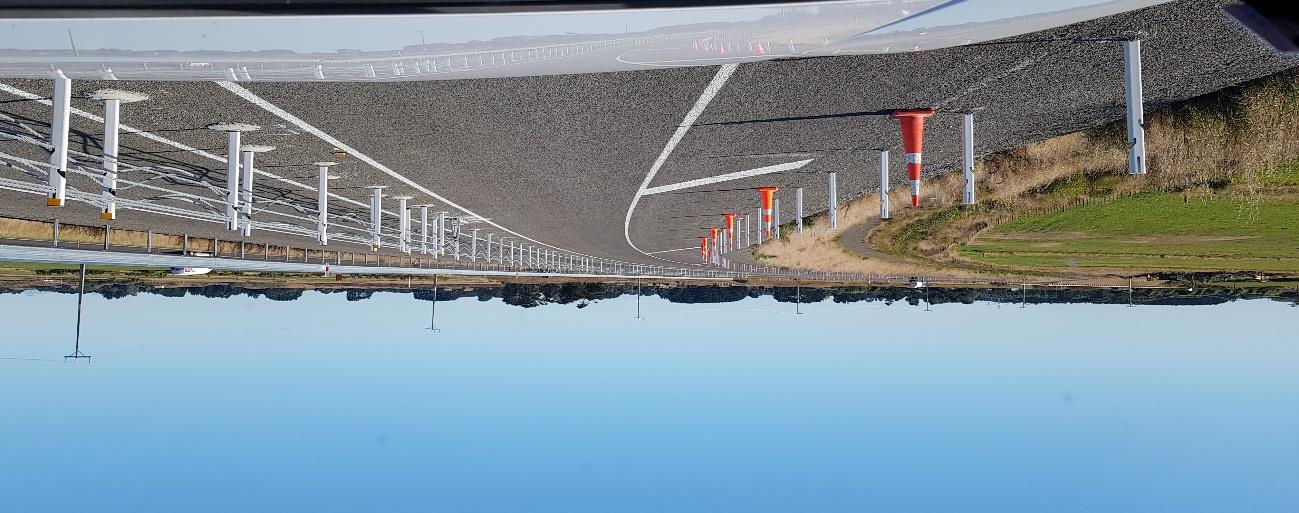
Client Decision
Agree with BBO and Safety Engineer’s responses. No further action
required.
Action Taken
N/A
2.1.4
Median width and barrier deflection on northern curve
MINOR
Frequency Rating
INFREQUENT
Severity Rating
UNLIKELY
1982
Median shoulder width of 1.5 m is provided throughout the project extent. A vehicle that has
lost control on the 450 m radius (approx.) curve at the northern end may deflect into oncoming
Act
traf f ic. When struck, the barrier debris could fal loosely within the northbound traffic lane.
Information
Recommendation
Official
Consider adjusting the median edge line on the southbound approach to the Moutoa Floodway
Bridge (Whirokino) to increase the deflection zone of the barrier if struck.
the
Designer Response
BBO: Increasing the barrier offset on the right hand side by adjusting
the median edge line will reduce the shoulder width on the left hand
side, which is already minimal. The risk described in the audit concern
under may be less than the risk of reducing the left hand shoulder width
(reduced sight distance; reduced space for cyclists and stopped
vehicles). Propose no change be made.
Saf ety Engineer
The suggested remedy from BBO does not consider moving the outside
barrier to accommodate the changed edge lines.
The based on the layout and existing shoulder (behind the barrier), it
may be possible to move the outside barrier and accommodate
Released
suggested increase in deflection zone without having to widen the seal
width. However, the cost of adjusting the barrier needs to be weighted
against mitigation of the minor risk.
The risk is low enough that if the cost is too high no action is necessary.
Client Decision
Agree with BBO response. No further action required.
12 |
GHD | Report for New Zealand Transport Agency - Whirokino Trestle and Manawatu River Bridge Replacement Post
Construction Road Safety Audit, 125/09290/00
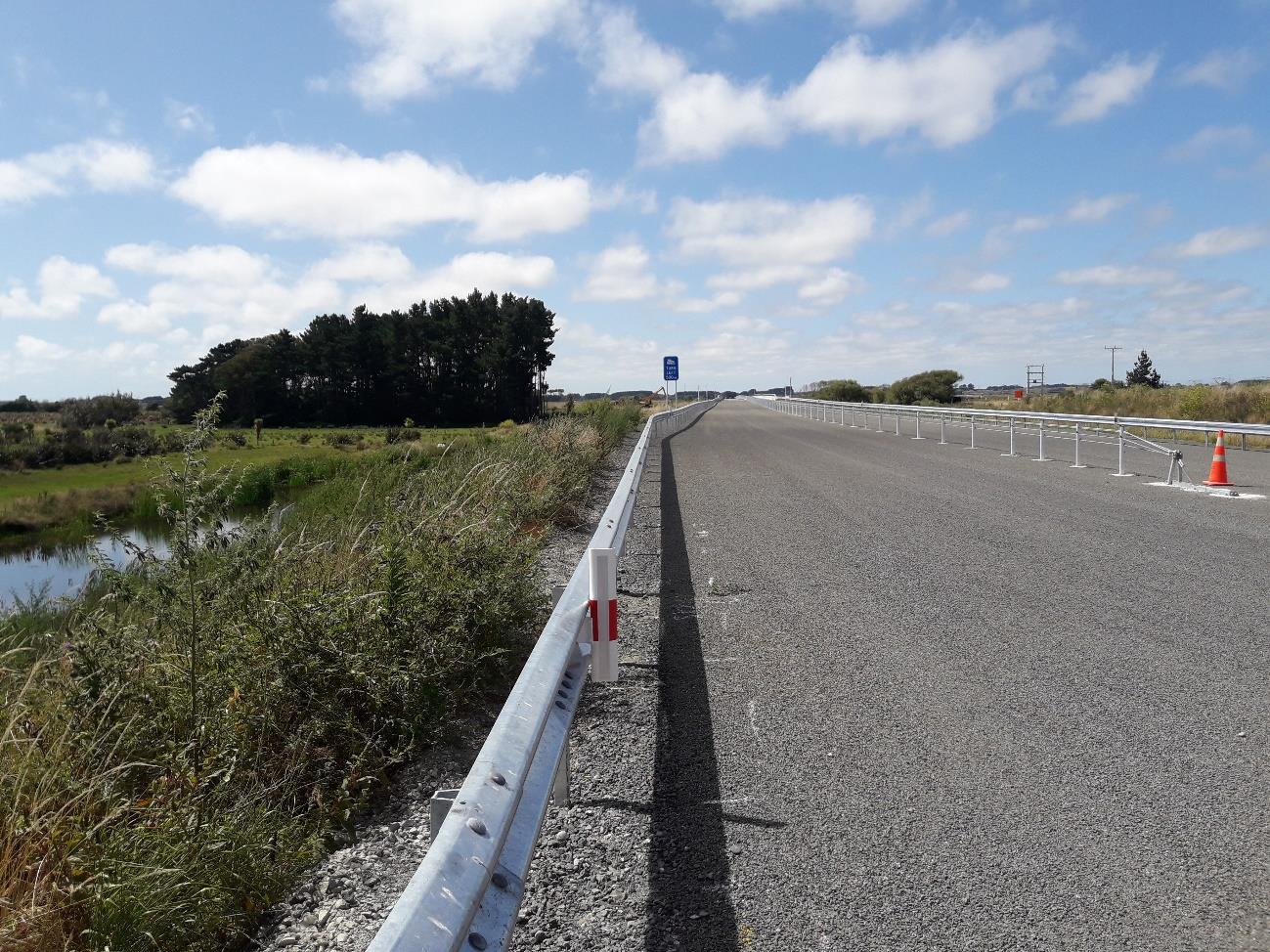
Action Taken
N/A
2.1.5
Northbound edge barrier south of river bridge
MINOR
Frequency Rating
INFREQUENT
Severity Rating
UNLIKELY
There is a sharp change in direction greater than 1:30 taper rate of the edge barrier between
the f arm access and the motorists service sign.
1982
Act
Information
Official
the
Recommendation
Reinstall barrier with appropriate taper rate.
under
Designer Response
Contractor: The taper has been instal ed as per design but extended an
extra 2 rails away f rom the shoulder to step over the Chorus fibre. It
then runs parallel with the fibre as can be seen in the near part of the
photo. It is difficult to determine a barrier taper as the lane alignment is
on a horizontal curve and the barrier is tapering outwards as the
shoulder widens. The taper was measured as 1:16.8 which is not the
sharpest on the project. The taper looks much smoother with the line
marking in place.
Released
BBO: The barrier is 3.0m from the edge line at the start of the taper
which is outside the shy line (refer AGRD Part 6 Table 6.4). For
barriers outside the shy line a flare rate of 1:17 is acceptable for a
design speed of up to 110km/h (refer AGRD Part 6 Table 6.5).
Propose no change be made.
GHD | Report for New Zealand Transport Agency - Whirokino Trestle and Manawatu River Bridge Replacement Post
Construction Road Safety Audit, 125/09290/00 | 13
Saf ety Engineer
As the barrier is outside the shy line 1:17 should be the max flare rate.
At 1:16.8, this is steeper than acceptable.
If a decision is made to change the flare rate, it is recommended that
the change be made to flatten the flare beyond 1:17 as going to the
expense of making the change should try to improve it beyond the
minimum.
Client Decision
Agree with BBO response. No further action required.
Action Taken
N/A
1982
2.1.6
Barrier installation
COMMENT
Act
The wire-rope barrier on the northbound edge line between Link Road and the Moutoa
Floodway Bridge (Whirokino) had not yet been tightened at the time of the audit.
Information
Official
the
under
Released
14 |
GHD | Report for New Zealand Transport Agency - Whirokino Trestle and Manawatu River Bridge Replacement Post
Construction Road Safety Audit, 125/09290/00
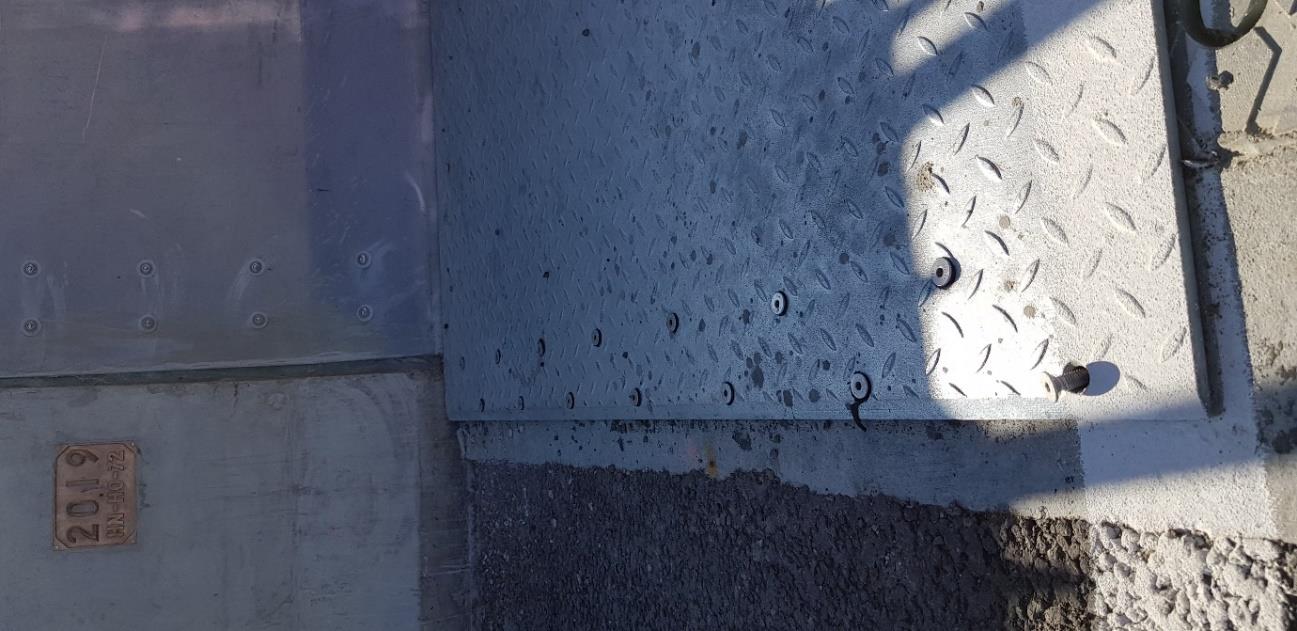 2.2
Bridge shoulders
2.2.1
Attachment system for plates covering expansion joints
2.2
Bridge shoulders
2.2.1
Attachment system for plates covering expansion joints
SERIOUS
Frequency Rating
COMMON
Severity Rating
VERY LIKELY
Metal plates covering the expansion joints have been provided on the shoulders to be
traversable by cyclists. These metal plates are attached on the leading edge only with short
screws approximately 2 cm in length. During the line marking inspection screws were observed
to be loose and easy to loosen. With traffic passing over the bridge and other sources of
1982
vibrations, these plates are likely to become detached becoming a hazard for all road users if
kicked up by vehicle traffic and caught in the wind.
Act
Information
Official
Recommendation
Revisit this detail of how this is going to be mounted so that it does not vibrate loose and
the
become and hazard for cars driving over/next to the plate.
Designer Response
Novare: All the screws have been tack welded at the cover plate to
ensure it is securely in place and the issue has not been observed
since.
under
BBO: Suggest this is monitored and thoroughly inspected at the end of
the DNP before accepting as a permanent solution.
Saf ety Engineer
Recommend this is monitored during the defects period as this issue
should be fixed immediately. Loose plates and loose screws are
hazardous to traffic immediately, especially motorcyclists.
Client Decision
Agree with BBO and Safety Engineer’s responses. No further action
required.
Released Action Taken Plates to be carefully monitored during DLP.
November 2020 update: Plates are being monitored. Bolts are holding
well to date.
GHD | Report for New Zealand Transport Agency - Whirokino Trestle and Manawatu River Bridge Replacement Post
Construction Road Safety Audit, 125/09290/00 | 15
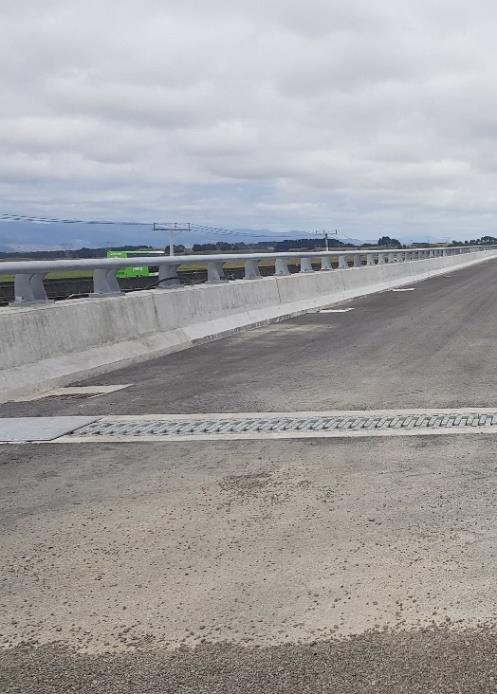
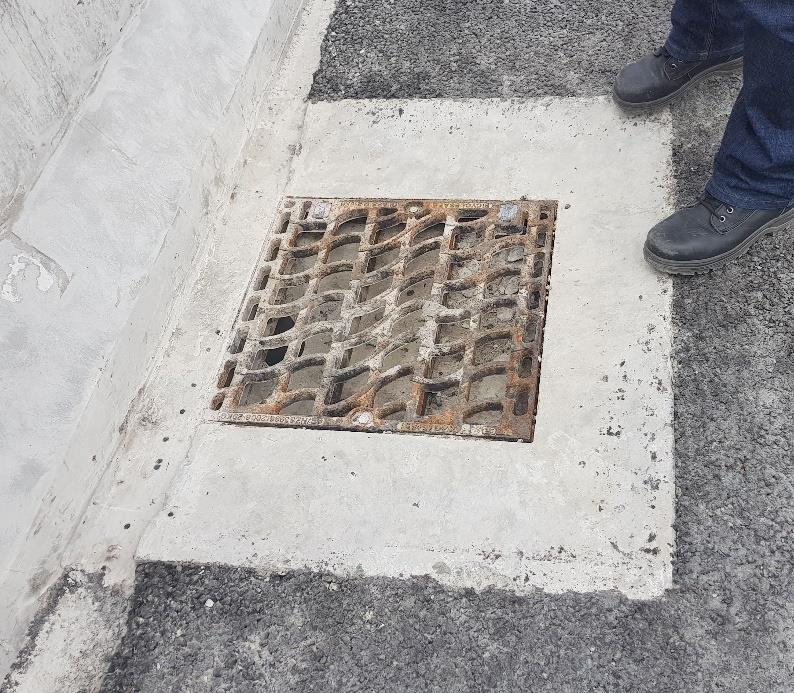
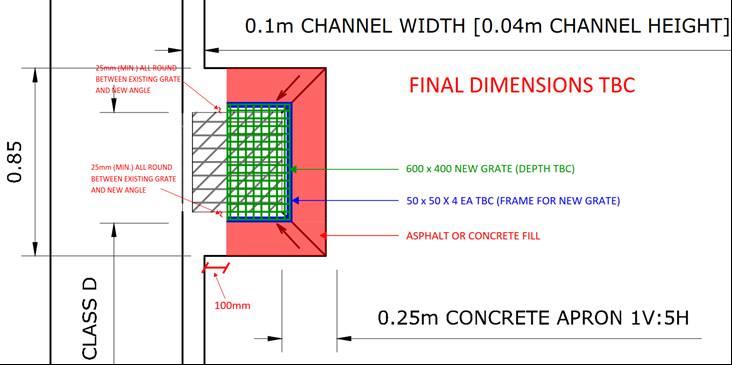 2.2.2
Sump form and depth
SIGNIFICANT
2.2.2
Sump form and depth
SIGNIFICANT
Frequency Rating
COMMON
Severity Rating
VERY LIKELY
Sumps along the sealed shoulders of the bridges are located approximately 50 mm below the
seal surf ace. On the Moutoa Floodway Bridge (Whirokino) sumps are spaces approximately
every 50 m. “Confident and courageous” type of cyclists will use the shoulder rather than the
shared path. The dips at 50 m spacing will create an uncomfortable ride for cyclists who
consistently use the shoulder, and will cause them to ride on the non-undulating surface closer
to the traffic lanes, increasing their risk.
1982
Act
Information
Recommendation
Official
Consider a sump solution level with the surfacing.
Designer
Novare: A solution has been proposed. If we get a go-ahead from everyone, we
the
Response can start working on the details.
under
Released
BBO: The Contractor has also been asked to investigate using a concrete planer
to reduce the slopes surrounding the sump, as an alternative to the above
solution. If feasible, this would be preferred by BBO.
16 |
GHD | Report for New Zealand Transport Agency - Whirokino Trestle and Manawatu River Bridge Replacement Post
Construction Road Safety Audit, 125/09290/00
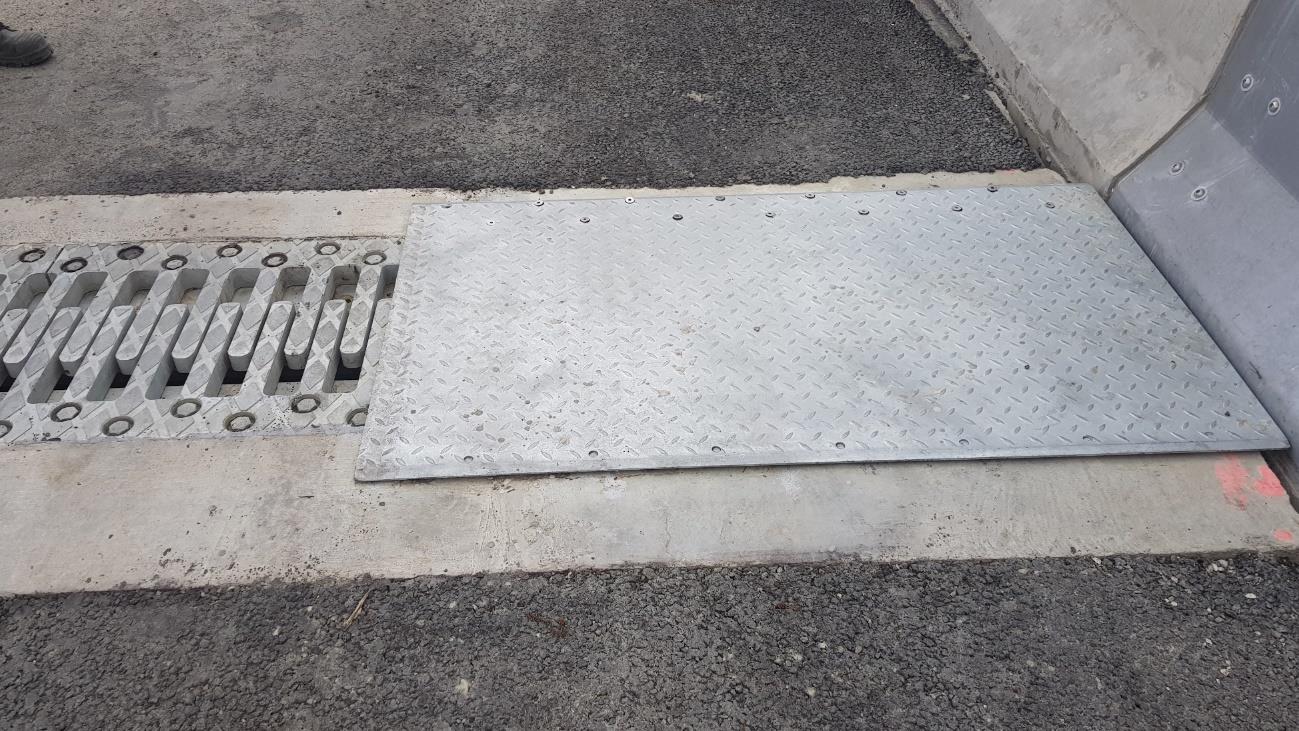
Saf ety
In deciding between the two options, the Novare solution would be superior with
respect to cyclist comfort.
Engineer
Rising the grate would also deal with the issues in 2.6.1 where Novare
recommends raising the sump grate height to deal with the likelihood of the drain
blocking due to debris.
Client
Agree with the Safety Engineer’s response. Given the shoulder width is only
Decision
1.5m, f rom a safety perspective, the ful width needs to be available for cyclists at
all times and at present, this is not the case. Furthermore, the planning option
(without raising the level of the sump grate) is really only a partial mitigation
measure as the perceived hazard still remains. Very careful thought needs to be
1982
given to the final solution, as any works will result in delay and disruption to road
users and is likely to attract negative feedback if the comms are not handled
appropriately.
Act
Action
June 2021 update: Grates have been raised level with the road surface. No
Taken
f urther action required.
2.2.3
Grip on metal plates covering expansion joints
MODERATE
Frequency Rating
OCCASIONAL
Severity Rating
LIKELY
Metal plates cover the expansion joints on the shoulder of the two bridges within the project.
Information
These metal plates have marco-grip pattern on their top side, but lack grip between and so have
lower grip than typical surfacing, particularly when damp/wet. This reduced grip will increase the
likelihood of cyclists or motorcyclists riding on the across the joint losing control.
Official
the
under
Released
Recommendation
Consider methods to increase the grip on the metal plates.
Designer Response
Novare: The plates can have a grit filled coating applied to the top to
increase slip resistance.
GHD | Report for New Zealand Transport Agency - Whirokino Trestle and Manawatu River Bridge Replacement Post
Construction Road Safety Audit, 125/09290/00 | 17
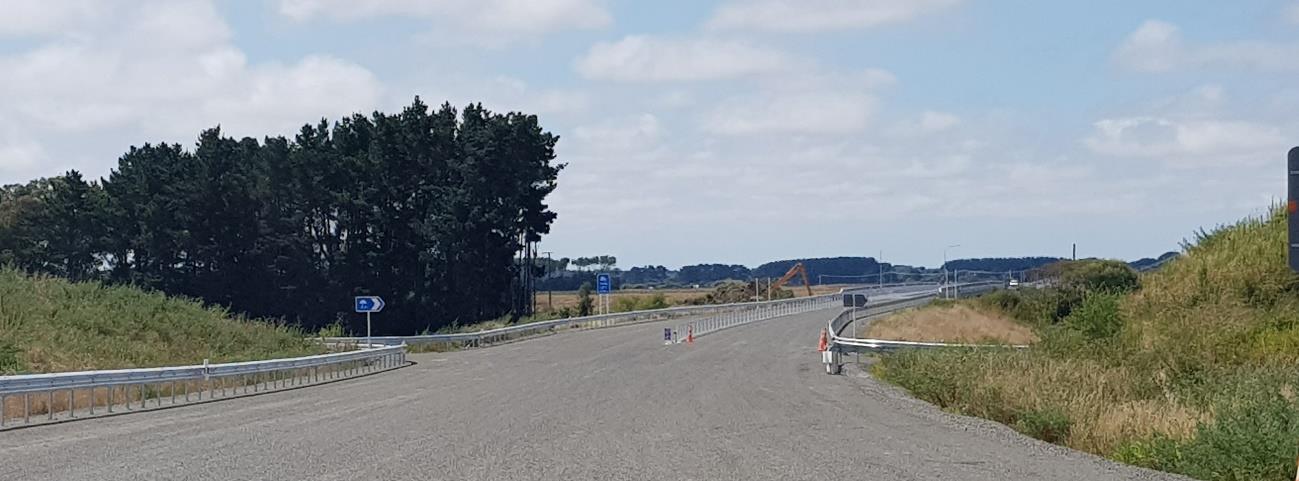 BBO:
BBO: Agree with the Novare proposal.
Saf ety Engineer
The grit f illed coating is expected to mitigate this issue.
Client Decision
Agree with BBO and Safety Engineer’s responses.
Action Taken
November 2020 update: Coating to be applied during closures for
second coat sealing.
June 2021 update: Work completed, no further action required.
1982
2.3
Signs
Act
2.3.1
Rest area northbound signage
SIGNIFICANT
Frequency Rating
OCCASIONAL
Severity Rating
VERY LIKELY
In a previous phase Road Safety Audit, concern around right turn movements into the rest area
was identified, the accepted solution was to only signpost the rest area for southbound traffic.
However the rest area has now been signed for northbound traffic as well.
Information
Official
the
Recommendation
Remove the northbound facing rest area sign, or explain what mitigation has been implemented
to reduce risk for the northbound right turn movements.
under
Designer Response
BBO: The Client Decision and Action Taken for Item 2.2.3 of the
Specimen Design Road Safety Audit was to increase the edge barrier
of fsets, to provide road space for through vehicles to manoeuvre
around slowed or stopped vehicles turning into and out of the entrance .
On the one hand the sign for northbound traffic could encourage right
turns in and out. On the other hand, omitting the sign might result in
drivers making late decisions to turn into the entrance. Weighing up the
Released
risks, BBO preference is to remove the signs for northbound traffic.
Saf ety Engineer
Remove the sign for northbound traffic.
Client Decision
Agree with the Safety Engineer’s response.
Action Taken
Sign to be removed.
18 |
GHD | Report for New Zealand Transport Agency - Whirokino Trestle and Manawatu River Bridge Replacement Post
Construction Road Safety Audit, 125/09290/00
November 2020 update: Signs have been removed, no further action
required.
2.3.2
Manawatu bridge cyclist warning
MODERATE
Frequency Rating
INFREQUENT
Severity Rating
VERY LIKELY
All cycle users are required to use the Manawatu River bridge shoulders on the southbound 1982
approach. Cyclist warning signs are considered inadequate as they located on the outside of a
wide shoulder.
Related but not within the issue: encouragement for cyclists to use the off-road cycle-path could
Act
be provided at the northbound left turn into Link Road and southbound left turn onto the river
bridge.
Recommendation
Designate the southbound shoulder from Whirokino Road over the Manawatu River bridge as a
cycle lane. Consider the use of green surfacing at the intersection and provide cyclist symbols
on the shoulder on the bridge.
Information
Designer Response
BBO: BBO are neutral regarding whether a southbound cycle lane
should be marked between Whirokino Road and the southern end of
the bridge. The design intent was that the cycle route ends at the point
the diversion around the floodway bridge re-joins the SH1 shoulder.
However, BBO are happy to defer this to the Transport Agency’s cycle
design specialists for a decision.
Official
Marking of short lengths of green surfacing to guide cyclists through
important junctions is supported, including the turn from the SH1
southbound shoulder onto the off road cycle path at the northern end of
the
the f loodway bridge, and the turn from the SH1 northbound shoulder
into Link Road to access the off road path.
Saf ety Engineer
Agree with designation of the cycle lane over the Manawatu Bridge, but
a decision needs to be made with marking the remaining section. If the
under markings are carried on, it may divert cyclists from the far safer off road
cycle path.
Client Decision
GP to discuss with BBO
Action Taken
November 2020 update: No action, pending resolution of existing MRB
retention f or an alternative cycle route over the river. If the existing
MRB is retained, it may be better not to mark a cycle lane over the road
bridge.
Released
June 2021 update: No further action required as part of the RSA. Now
that the decision has been made to demolish the existing MRB, any
saf ety improvements for cyclists on the new MRB, will be dealt with as
part of this phase of the project.
GHD | Report for New Zealand Transport Agency - Whirokino Trestle and Manawatu River Bridge Replacement Post
Construction Road Safety Audit, 125/09290/00 | 19
2.3.3
Cycle-path closed sign
MODERATE
Frequency Rating
INFREQUENT
Severity Rating
VERY LIKELY
Users are inf ormed that the cycle-path is closed by a single sign at each end prior to the cycle-
path. It is possible that users may miss or ignore this sign and continue ont o the cycle-path /
f loodway while in flood, mistaking the depth or speed of water and the consequential hazard (or
being unwilling to turn back). While this is considered to be very infrequent, it is consequence
would very likely result in death or serious injury.
1982
Recommendation
Provide a gate at the southern end of the pathway at Whirokino Road and at the northern end at
Act
the f loodway stopbank to prevent access when the cycle-path is closed.
This could also prevent the public travelling through the cycle-path while it is being maintained.
Designer Response
BBO: Flood velocities are low and there is no sudden drop into deep
water, so the risk of serious harm is very low. A warning sign should be
suf ficient.
Saf ety Engineer
The use of a gate raises problems for the long-term operation of the
cycle path as our contractor must open and close it pre- and post-
f lood. It is also difficult to construct a pedestrian/cyclist proof fence and
Information
people may stil use it if they slip past.
Straying off the cycle path may result in a cyclist entering deep water
areas, so we need to ensure the existing fencing will be adequate in
f lood conditions to protect cyclists if no gates are installed.
Would suggest that an information sign explaining the risks before
Official
entering the danger zone could be an option provided its position was
not distracting/observable to the bridge traffic.
Client Decision
Agree with BBO response. However, there may be benefit in providing
the
a supplementary sign explaining the hazard, as suggested by the
Saf ety Engineer.
Action Taken
Investigate supplementary warning sign.
November 2020 update: Sign not yet installed.
under June 2021 update: Sign currently ordered and awaiting instalation. No
f urther action required.
2.3.4
Sign text sizing and spacing
MINOR
Frequency Rating
OCCASIONAL
Severity Rating
VERY UNLIKELY
Released
Throughout the project extent there are numerous site specific signs which have text size and
spacing not compliant with the traffic control devices manual. Generic signs such as Passing
Lane Ahead did not seem to have the same text issues.
Instances include:
20 |
GHD | Report for New Zealand Transport Agency - Whirokino Trestle and Manawatu River Bridge Replacement Post
Construction Road Safety Audit, 125/09290/00
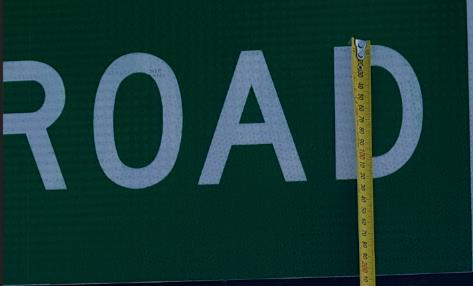
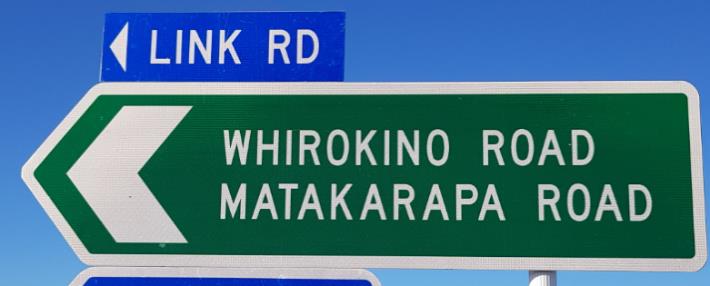
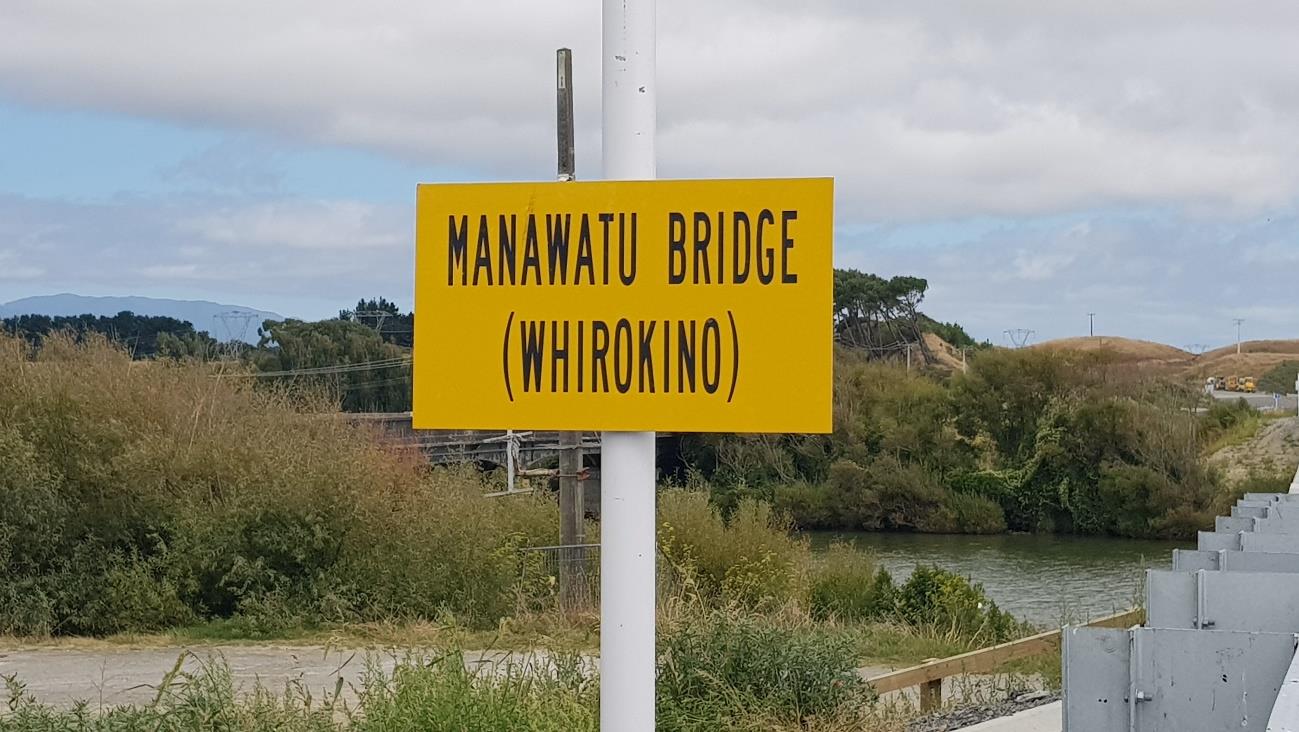
Whirokino Road and Matakarapa Road text height on directional sign approaching Link
Road.
Manawatu River Bridge place sign (IG-14) has narrowly spaced lettering making it difficult
1982
to read.
Act
Information
Official
Recommendation
the
Recommend reviewing all of the signs within the project extent to confirm they meet TCD /
MOTSAM requirements.
Designer Response
Contractor: The f ont used on the dual name IDS sign was done in
120mm HIROAD D as Specified in MOTSAM.
under Street name lettering should be Series D Capitals in the same size as
the lower-case letters of the destination. This would be 160/120mm.
The normal HIROAD EM font for destinations is Capital of 160mm and
lower case of 120mm.
As f or the compression for the bridge signs, they have been
compressed for size reasons within the 15% maximum as specified in
MOTSAM/TCD.
Released
If they were not compressed the final size would be larger.
Compression is normal practice with bridge signs - due to their location
they can protrude onto the road.
BBO: All signs are compliant.
GHD | Report for New Zealand Transport Agency - Whirokino Trestle and Manawatu River Bridge Replacement Post
Construction Road Safety Audit, 125/09290/00 | 21
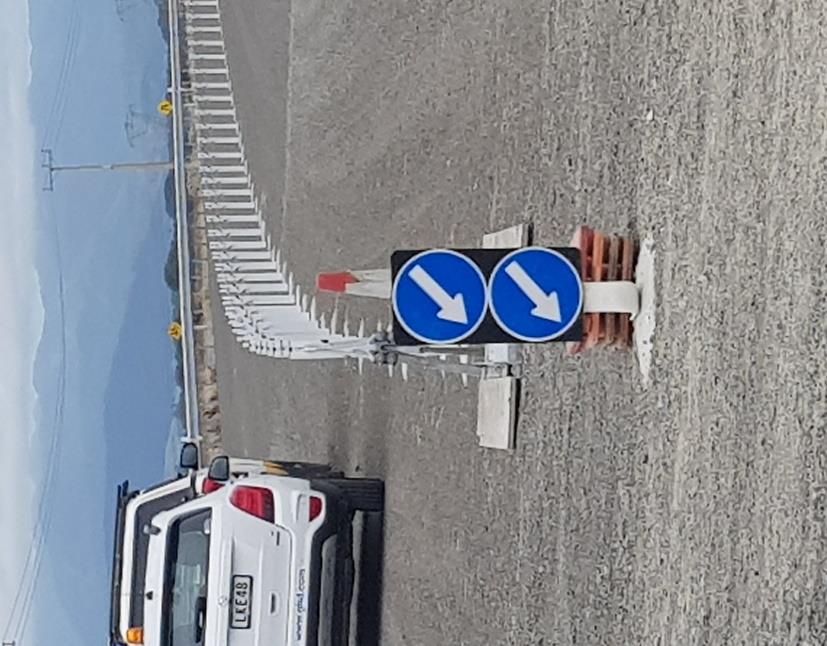
Saf ety Engineer
According to the designers, these signs are compliant. Safety audits
are not about compliance, but addressing the issues brought up by the
SAT. In this case, the fundamental question would be about legibility of
the sign and the effects of this on safety.
The compression and legibility of the bridge name signs are unlikely to
be a saf ety risk.
Arguably the Whirokino Road and Matakarapa Road may have a safety
ef f ect as they need to advise drivers of their destination well in advance
of deciding to turn. Suggest a review at normal travel speeds of these
1982
signs to see if they are sufficiently legible for alert drivers who may be
searching for them.
Client Decision
Agree with BBO and Safety Engineer’s responses.
Act
Action Taken
Carry out site inspection to confirm legibility at normal travel speeds.
November 2020 update: Inspection not yet carried out.
June 2021 update: Inspection completed and sign considered legible.
No f urther action required.
2.3.5
Median barrier northern end RG-17 sign
MINOR
Information
Frequency Rating
OCCASIONAL
Severity Rating
UNLIKELY
The RG-17 “keep lef t” sign mounted on the southbound approach to the northern end of the
median barrier is slightly off-set to the right of the barrier terminal. This could cause a slight
perception issue for the location of the barrier.
Official
the
under
Released
22 |
GHD | Report for New Zealand Transport Agency - Whirokino Trestle and Manawatu River Bridge Replacement Post
Construction Road Safety Audit, 125/09290/00
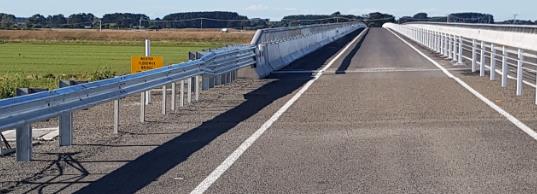 Recommendation
Recommendation
Shif t the RG-17 sign slightly left to align the centre of the sign with the barrier terminal.
Designer Response
The barrier terminal is part way around the curve so the apparent offset
may be a visual effect. The situation will be checked now that the road
has been marked and the sign will be relocated if the location is
misleading.
Saf ety Engineer
Review as suggested by the designers at normal approach speeds.
1982
Client Decision
New posts have been installed. No further action needed.
Act
Action Taken
N/A
2.3.6
Floodway bridge sign height
COMMENT
The sign f or the northbound facing Moutoa Floodway Bridge (Whirokino) is too low on its
support post and is obscured behind the barrier.
Information
Official
the
BBO Comment: The sign height should be adjusted by the Contractor.
under
Client Decision: Agree with BBO response.
November 2020 update: Bridge number sign added on top. Height set to top of Texas rail to
avoid moving sign out to 7.5m for heavy haulage. No further action required.
2.3.7
Side-road speed limit signs
COMMENT
Speed limit signs on the side-road have not yet been installed at the time of the audit.
Released
GHD | Report for New Zealand Transport Agency - Whirokino Trestle and Manawatu River Bridge Replacement Post
Construction Road Safety Audit, 125/09290/00 | 23
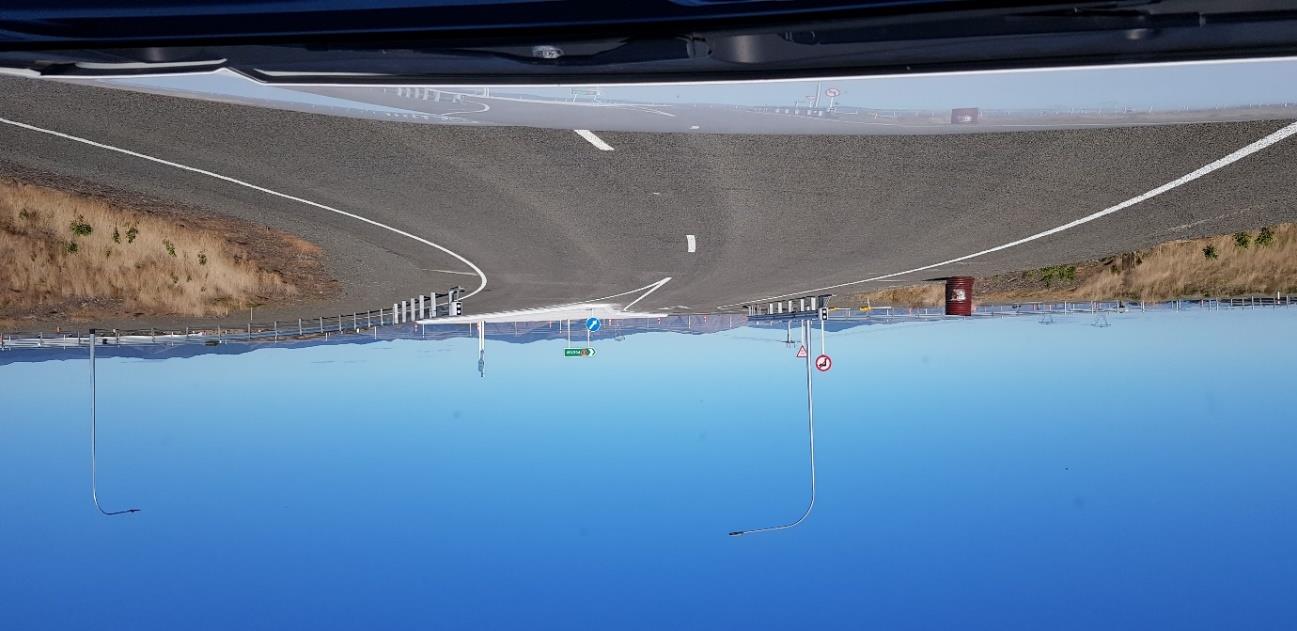
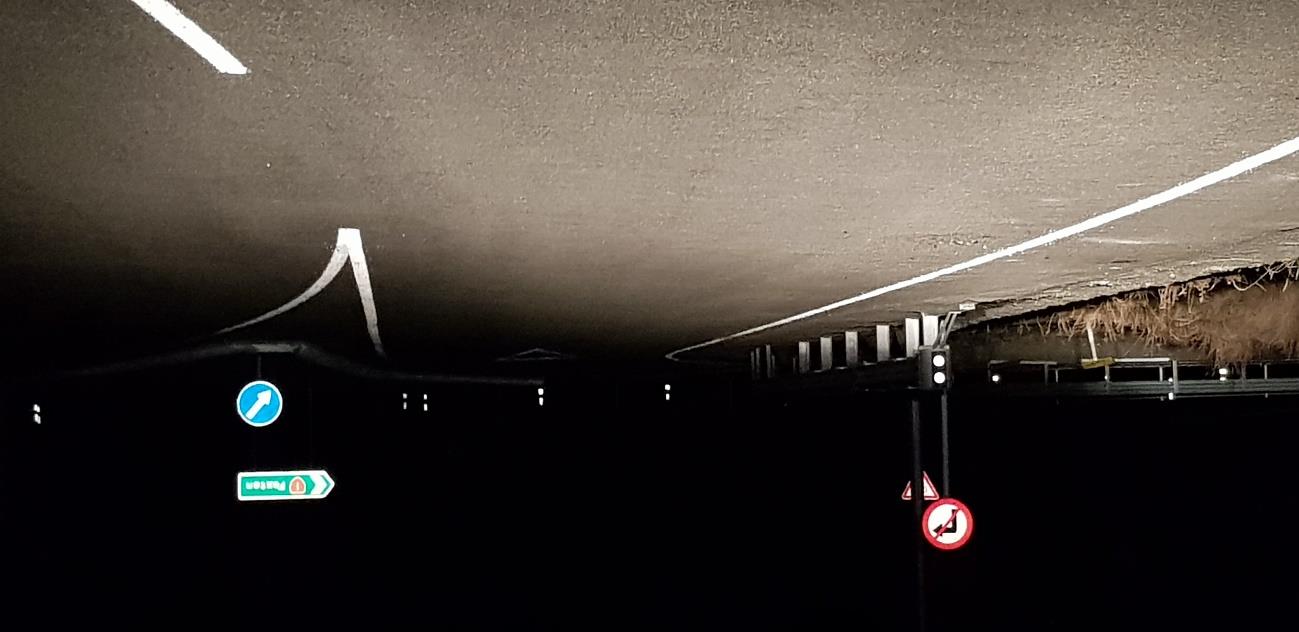 2.4
Line-marking and delineation
2.4.1
Link Road limit line visibility
MODERATE
2.4
Line-marking and delineation
2.4.1
Link Road limit line visibility
MODERATE
Frequency Rating
INFREQUENT
Severity Rating
LIKELY
Visibility through to the limit line is short due to the curve of the throat island and the elevation
prof ile change of the road.
Visibility of the giveway sign is obstructed by both the position of the lighting column and the no
right-turn sign.
1982
The advanced warning giveway pavement marking is too close to the limit line to be visible.
The giveway sign size appears to be 600 mm, and should be 900 mm.
Act
Information
Official
the
under
Released
Recommendation
1. Gate the giveway sign so that approaching road users do not overshoot the intersection
and hit the median barrier.
2. Raised intersection chevron board sign for opposite intersection to improve intersection
visibility.
24 |
GHD | Report for New Zealand Transport Agency - Whirokino Trestle and Manawatu River Bridge Replacement Post
Construction Road Safety Audit, 125/09290/00
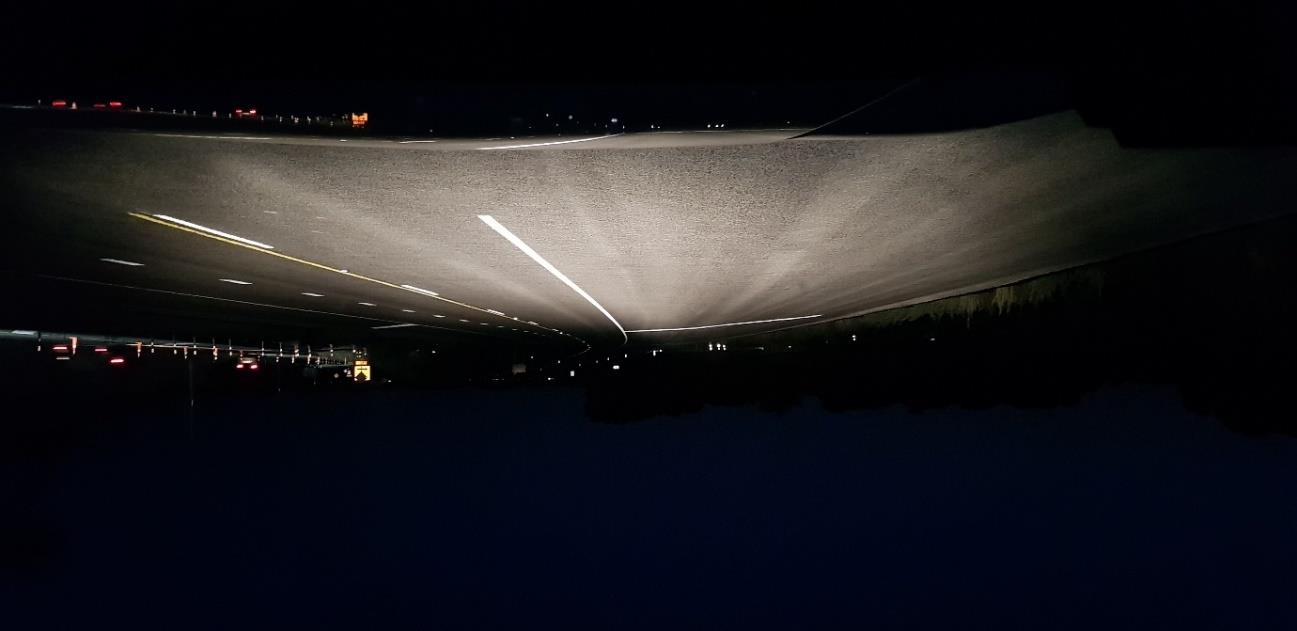
Designer Response
BBO: Agree with audit concerns. All recommendations will be
addressed.
Saf ety Engineer
Agree with the audit concerns. Make and check adjustments to the
sign both day and night.
Client Decision
Agree with BBO and Safety Engineer’s responses.
Action Taken
All signage changes to be implemented.
1982
November 2020 update: 900mm size Give-way signs installed, gated at
both intersections. Chevron signs installed. No further action required.
Act
2.4.2
Over-dimension vehicle staging area
MODERATE
Frequency Rating
INFREQUENT
Severity Rating
LIKELY
The northbound over-dimension vehicle staging area south of the start of median barrier is a
significantly wide shoulder currently hatched. The purpose of this area could be unclear for most
road users and could encourage undesirable road user behaviours, and at night may even be
mistaken as the actual live lane. This issue was previously identified as a comment in the
previous audit.
Information
Official
the
under
Recommendation
Consider providing some form of delineation and / or separation, either in the form of a
mountable island between the carriageway (incl. standard hard-shoulder) and over-dimension
vehicle staging area, with edge marker posts and red edgeline RRPMs at the entry.
Released Designer Response
BBO: Agree with audit concerns. Final markings will include ATP edge
lines which will provide better delineation than the initial markings.
Additional diagonal bars could also be applied. They are currently at
50m centres. Suggest two additional bars in between each current pair
of diagonal bars, giving 16.7m spacing.
GHD | Report for New Zealand Transport Agency - Whirokino Trestle and Manawatu River Bridge Replacement Post
Construction Road Safety Audit, 125/09290/00 | 25
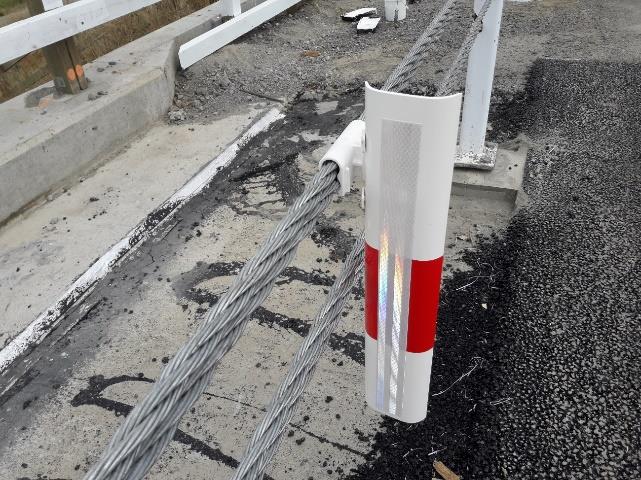
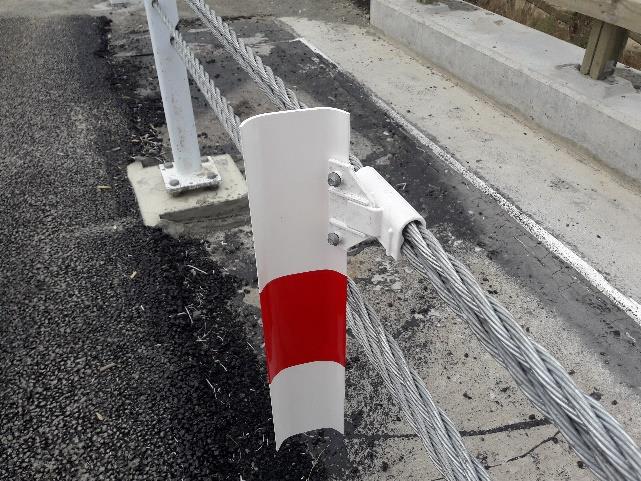
Saf ety Engineer
Agree with the designer’s solution.
Client Decision
Agree with BBO and Safety Engineer’s responses.
Action Taken
All road marking changes to be implemented.
November 2020 update: Additional bars to be applied after second coat
sealing.
June 2021 update: Additional bars have been installed. No further
action required.
1982
2.4.3
Wire-rope barrier edge marker posts
MINOR
Act
Frequency Rating
INFREQUENT
Severity Rating
UNLIKELY
The edge marker posts on the wire rope barrier can move under force, or during adverse
weather conditions, at a time when they are required the most. This will result a slight offset
discrepancy between the opposite edge marker posts. Additionally during the audit the spacing
between edge marker posts was inconsistent.
Information
Official
the
Recommendation
Identif y a solution to reduce movement of edge marker posts between wire rope barrier
supports.
Provide edge marker posts at consistent spacing.
under
Designer Response
Novare: It is understood that this is the standard that is being used
across the country. To ensure a sturdier connection, another clamp
could be attached the lower wire.
BBO: The attachment needs to be improved so that posts don’t slide
during weather events, cleaning etc. Spacings need to be uniform.
Saf ety Engineer
The need f or the spacing to remain consistent is important and we
recommend that the Novare solution is explored.
Released Client Decision Agree with BBO and Safety Engineer’s responses.
Action Taken
November 2020 update: Edge marker posts are not moving. Spacing
to be checked; otherwise no action required.
26 |
GHD | Report for New Zealand Transport Agency - Whirokino Trestle and Manawatu River Bridge Replacement Post
Construction Road Safety Audit, 125/09290/00
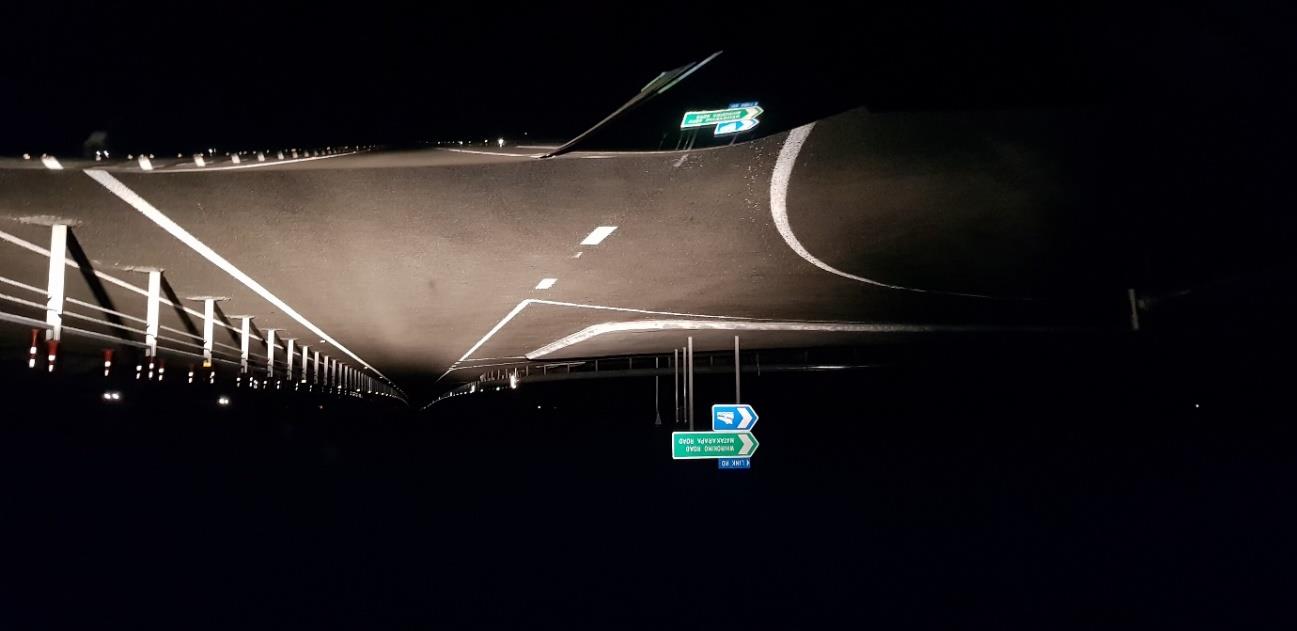 2.4.4
Night-time traffic island visibility
MINOR
2.4.4
Night-time traffic island visibility
MINOR
Frequency Rating
OCCASIONAL
Severity Rating
UNLIKELY
Poor visibility to the left turn northbound onto Link Road. Additional delineation may assist with
visibility of the edgeline and traffic island.
Note that street lighting at the intersection was not operating during the time of the audit and
may alter intersection and turning visibility.
1982
Act
Information
Recommendation
Provide white hatched marking as per MOTSAM.
Consider red RRPMs on the edgeline around the traffic island to help guide road users through
Official
the turn and kerb face reflectivity.
Designer Response
BBO: Agree with audit concerns. Chevron marking should be added in
the
accordance with MOTSAM 2.08.03. A review of the lighting and
delineation will be carried out after final markings have been applied.
Saf ety Engineer
Add chevron markings. Please note that island should be lit as well.
Client Decision
Agree with BBO and Safety Engineer’s responses.
under
Action Taken
All road marking changes to be implemented.
November 2020 update: Additional markings and RRPM’s to be applied
af ter second coat sealing.
June 2021 update: Work completed. No further action required.
Released
2.4.5
Night-time edgeline visibility
MINOR
Frequency Rating
INFREQUENT
Severity Rating
VERY UNLIKELY
There are several locations within the project extent with very wide shoulders, this provides a
significant offset between edge marker posts (free standing or barrier mounted) and the
edgeline.
GHD | Report for New Zealand Transport Agency - Whirokino Trestle and Manawatu River Bridge Replacement Post
Construction Road Safety Audit, 125/09290/00 | 27
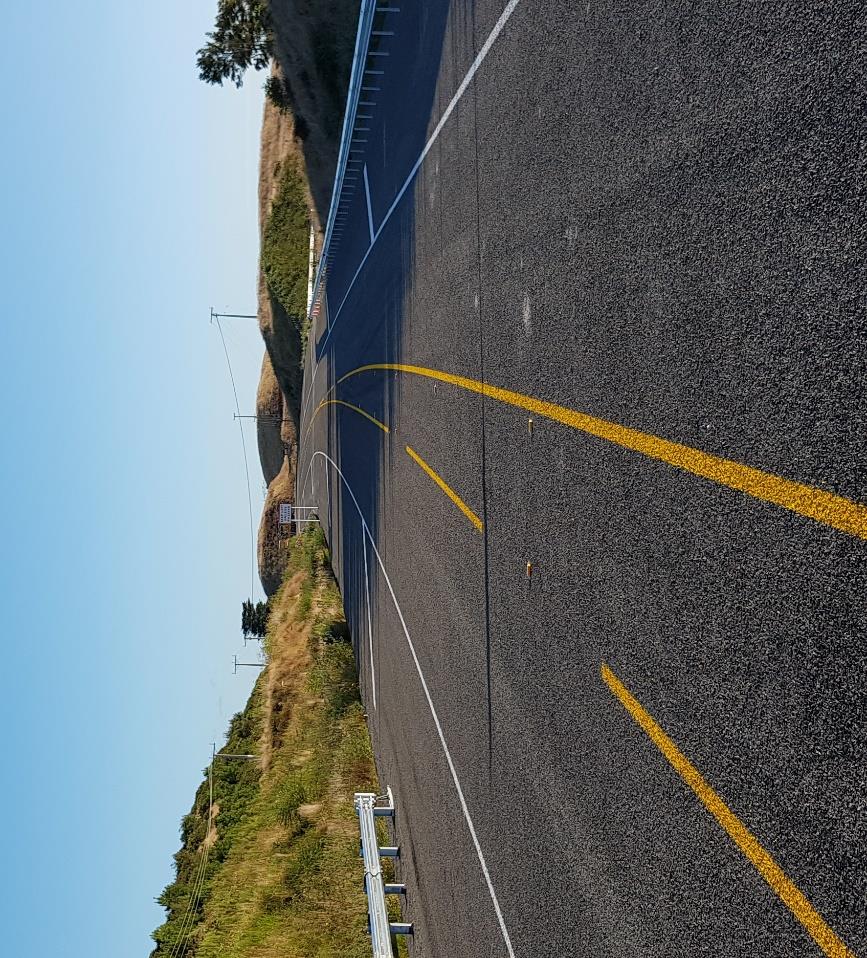
1982
Act
Recommendation
Information
Additional night time delineation of the edgeline should be provided where there is a shoulder
wider than 2.0 m. This could be red RRPM or other edgeline delineation methods.
Designer Response
BBO: Agree with audit concerns. Final markings will include ATP edge
lines which will provide better delineation than the initial markings.
Official
Saf ety Engineer
Agree with BBO’s plan for final markings.
Client Decision
Agree with BBO and Safety Engineer’s responses.
the
Action Taken
All road marking changes to be implemented.
November 2020 update: High performance markings to be applied after
second coat sealing.
June 2021 update: ATP instal ation on both the median and shoulder
under edgelines is imminent. No further action required.
2.5
Miscellaneous
2.5.1
Loose chip on shoulders and traffic lanes
MINOR
Frequency Rating
OCCASIONAL
Severity Rating
UNLIKELY
Released
There is a build-up of loose chip in front of Scruffy Dome sumps at either end of the bridge, this
should be cleared away to reduce potential ponding.
There is also a large amount of loose chip at the northern end of the bridge where the seal
changes from the bridge surfacing back to chip seal, creating a bump when driving over at low
speeds.
28 |
GHD | Report for New Zealand Transport Agency - Whirokino Trestle and Manawatu River Bridge Replacement Post
Construction Road Safety Audit, 125/09290/00
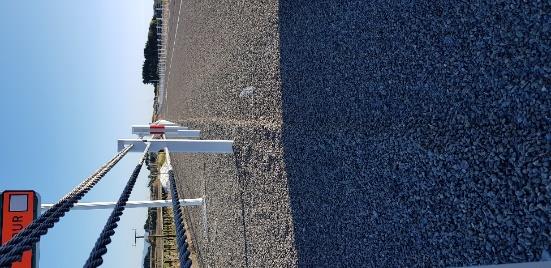
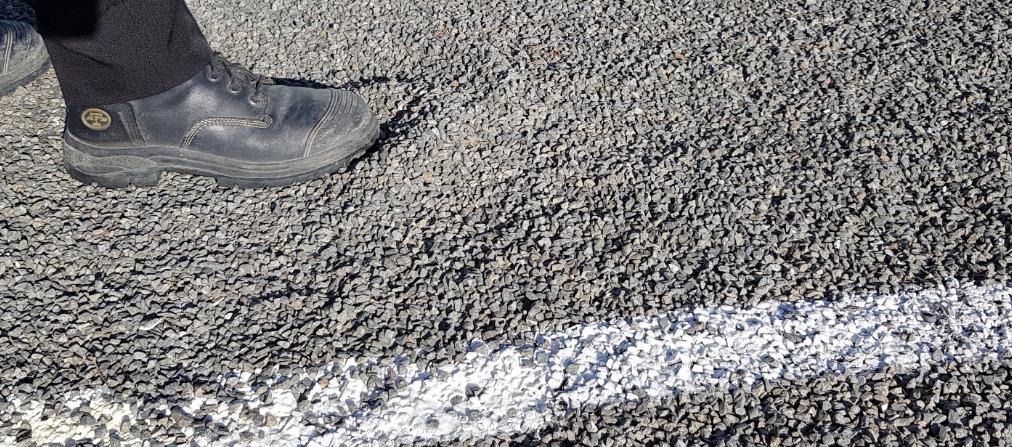
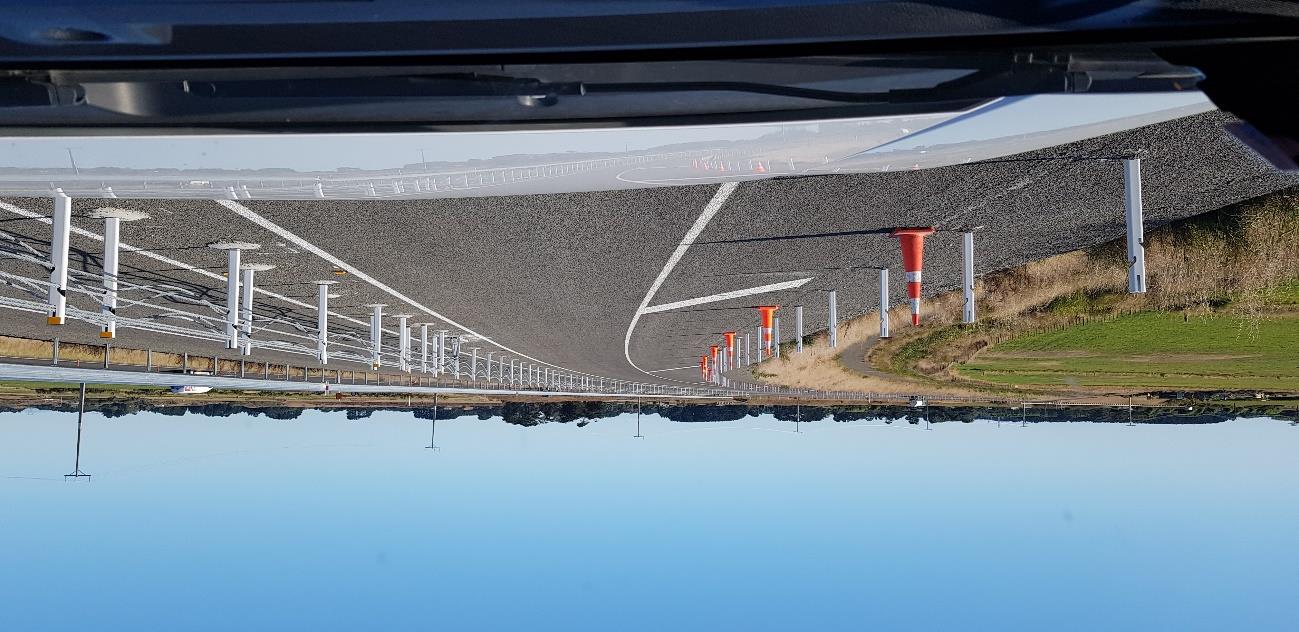
1982
Act
Recommendation
Sweep up loose chip on shoulders and traffic lanes of the project extent.
Designer Response
BBO: Agree with audit concerns. Contractor to address.
Saf ety Engineer
Address issues so that they do not crop up again during the operation
long term.
Client Decision
Agree with BBO and Safety Engineer’s responses.
Information
Action Taken
Contractor has already undertaken additional sweeping and is
monitoring the situation closely. No further action required.
2.5.2
Official
Potential vegetation
MODERATE
Frequency Rating
OCCASIONAL
Severity Rating
LIKELY
the
There is a potential for future vegetation growth on the embankment north of the Moutoa
Floodway Bridge (Whirokino) to reduce sight distance to the farm access.
under
Released
GHD | Report for New Zealand Transport Agency - Whirokino Trestle and Manawatu River Bridge Replacement Post
Construction Road Safety Audit, 125/09290/00 | 29
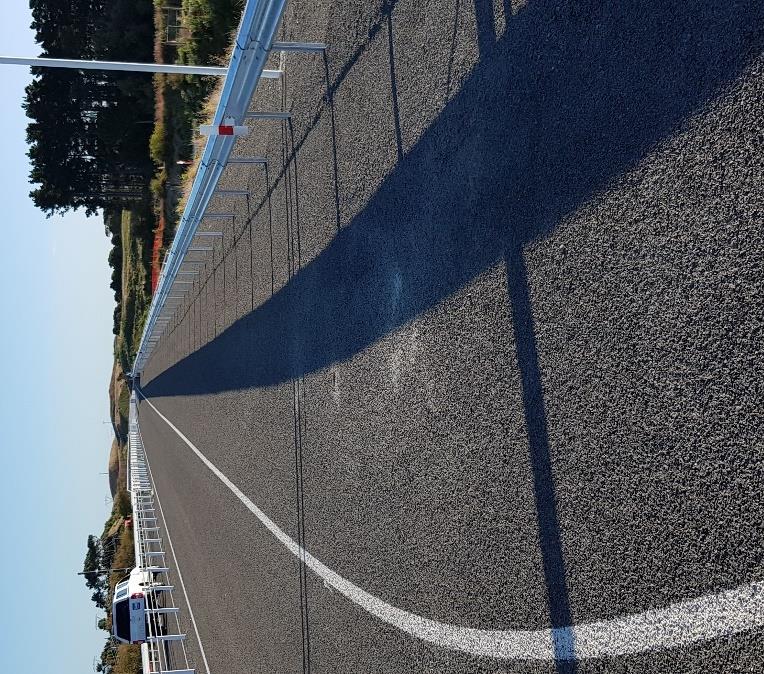 Recommendation
Recommendation
Ensure that low grow plants are used on the embankment.
Designer Response
The embankment has been planted in grass so driver’s eye to vehicle
body sight lines should not be obstructed.
Saf ety Engineer
The grass proposed should not grow to high, but this needs to be
reviewed at the end of the maintenance liability period so that the actual
ef f ects on visibility can be checked.
Client Decision
Agree with BBO and Safety Engineer’s responses.
1982
Action Taken
Monitor during DLP.
Act
2.5.3
Shoulder width approaching Link Road
MODERATE
Frequency Rating
OCCASIONAL
Severity Rating
LIKELY
Barrier is over 3.0 m back from edge line prior to the intersection, which will encourage drivers
to use the shoulder as a deceleration lane or slow vehicle bay. This is unsafe as drivers
overtake turning traffic will be obscured from drivers at the intersection turning left out.
Information
Official
the
under
Recommendation
Consider methods of reducing the effective shoulder width, this could include:
• flexible delineator post marking
• hatch marking with red RRPMs on the edgeline
Released • Relocation of the barrier.
Designer Response
BBO: Agree with audit concerns. Diagonal shoulder bars should be
applied between the bridge and Link Road. Combined with ATP final
30 |
GHD | Report for New Zealand Transport Agency - Whirokino Trestle and Manawatu River Bridge Replacement Post
Construction Road Safety Audit, 125/09290/00
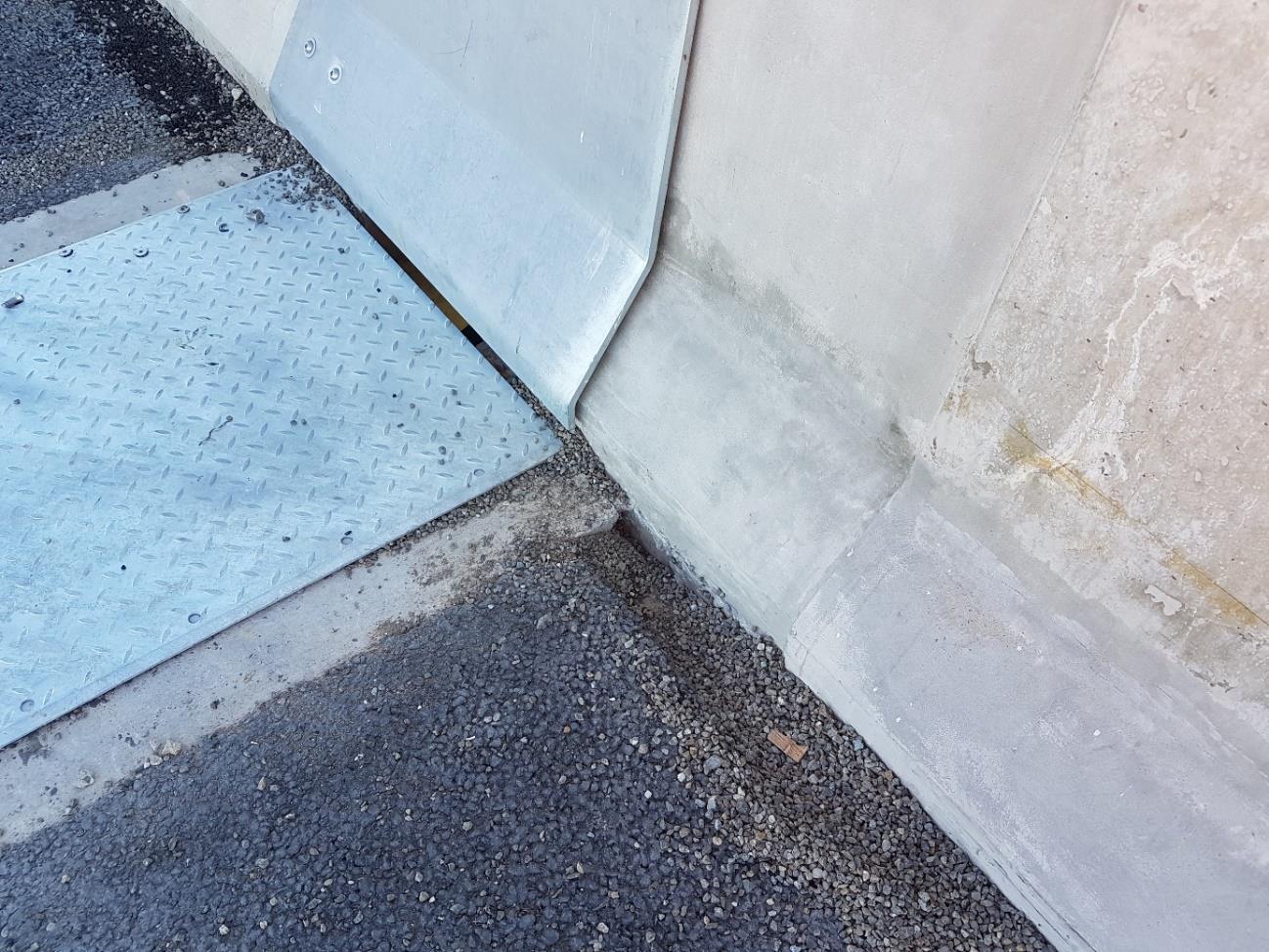
edge line markings, this should discourage vehicles from using the
shoulders as an auxiliary lane.
Saf ety Engineer
The approach recommended by BBO is adequate.
Client Decision
Agree with BBO and Safety Engineer’s responses.
Action Taken
All road marking changes to be implemented.
November 2020 update: Diagonal shoulder bars to be applied after
second coat sealing.
1982
June 2021 update: Additional bars have been added. No further
action required.
Act
2.5.4
Surfacing toe the barrier edge
COMMENT
There is a gap in the surfacing at the northern bridge expansion joint.
Information
Official
the
under
2.6
Maintenance comments
2.6.1
Sump drain size
COMMENT
Released
The drain outlets within sumps on and near the bridges appear to have a very small diameter
outf all, and could easily clog with vehicle and wind-blown debris. Clogged drains can cause
ponding on the bridge surface. With no visible access from the underside of the bridge for the
northbound traffic lane sumps and scruffy dome at bridge abutments, there is concern that
GHD | Report for New Zealand Transport Agency - Whirokino Trestle and Manawatu River Bridge Replacement Post
Construction Road Safety Audit, 125/09290/00 | 31
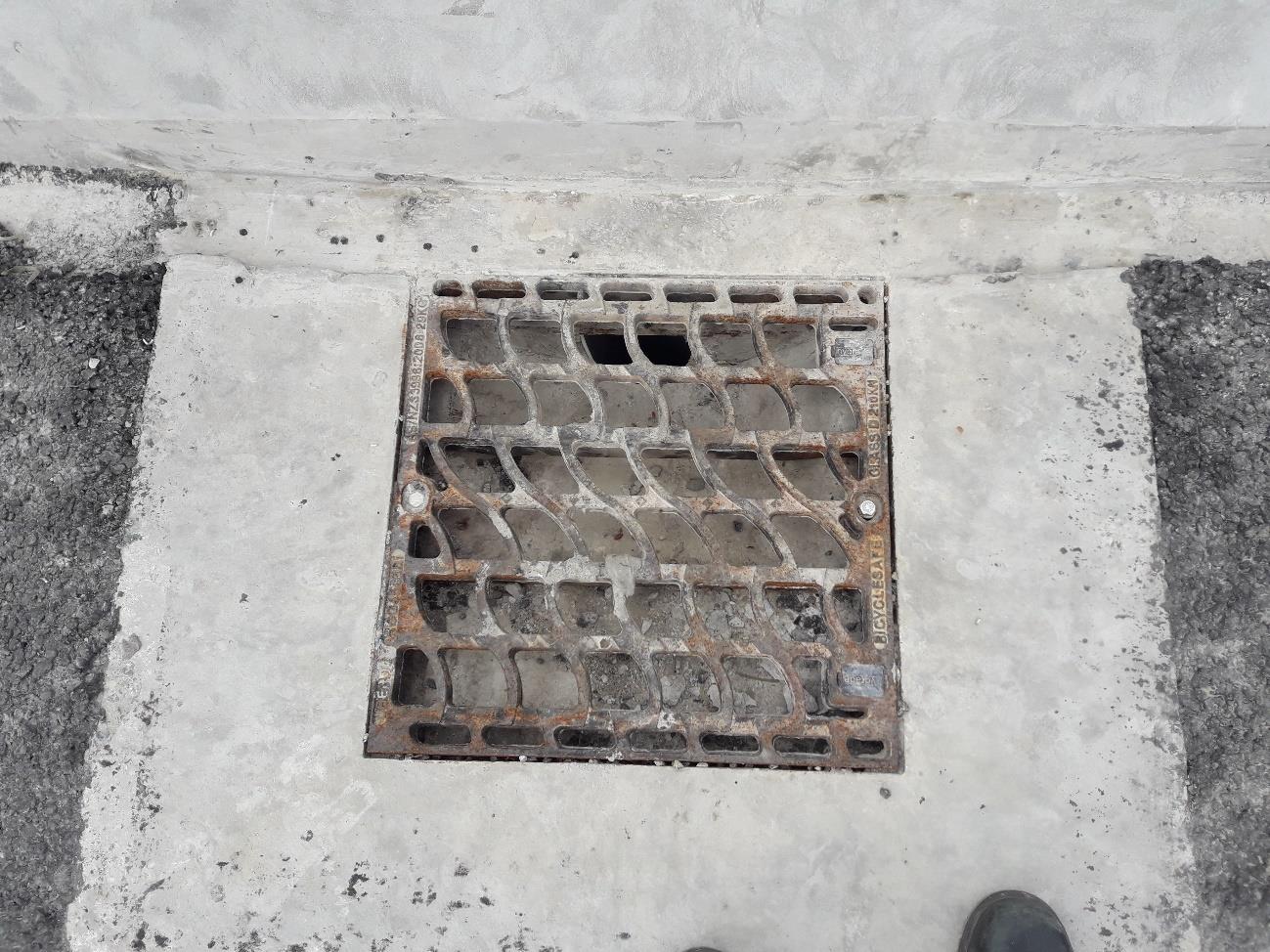
sumps on and near the bridge do not have adequate space for maintenance without closing the
lane.
Novare Comment: Downpipe nominal diameter is 150mm. In some locations a portion of the
pipe is partly obscured beneath the edge of the TL5 barrier. Full access to the top of the 150
dia pipe is available when the sump grate is raised and the pipe inlet is not partially blocked.
1982
Act
Information
Official
the
2.6.2
Traffic lane width and maintenance
COMMENT
There is approximately 5.75 m of carriageway space each side of the wire-rope barrier on the
bridges. To carry out maintenance with a shoulder closure, a 2.75 m traffic lane and 1 m lateral
saf ety zone are required to pass work vehicles. The remaining space for work vehicles is 2.0 m
under
including any shy space between the work vehicle and the barrier. It is likely that lane closures
will be required for any maintenance activities and consideration should be given to operational
practises and timing.
2.6.3
Surfacing at stock underpass
COMMENT
Surf acing at the stock underpass appears to be failing, this will require maintenance. In the right
hand photo below, there is a crater in the surfacing exposing base course.
Released
32 |
GHD | Report for New Zealand Transport Agency - Whirokino Trestle and Manawatu River Bridge Replacement Post
Construction Road Safety Audit, 125/09290/00
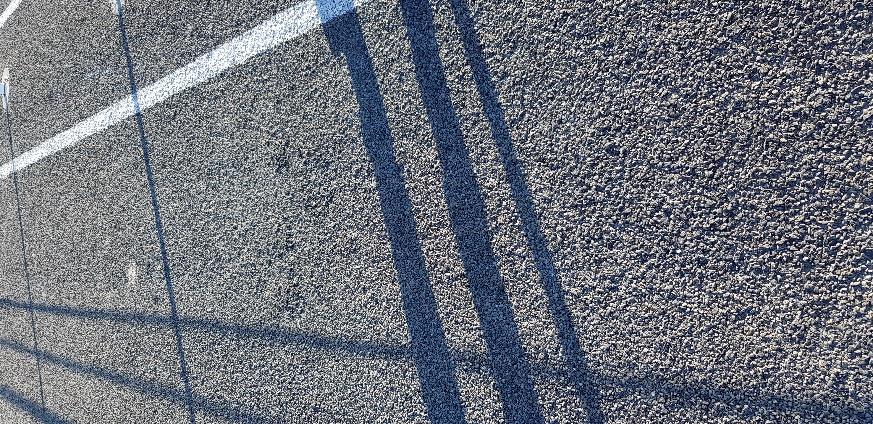
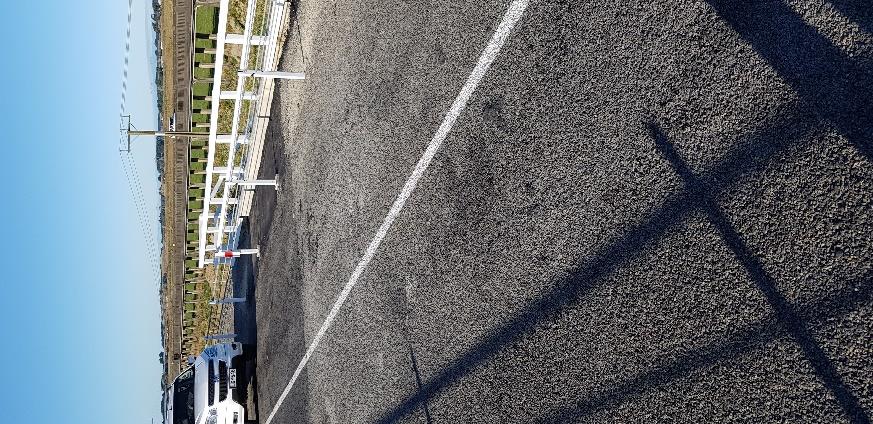
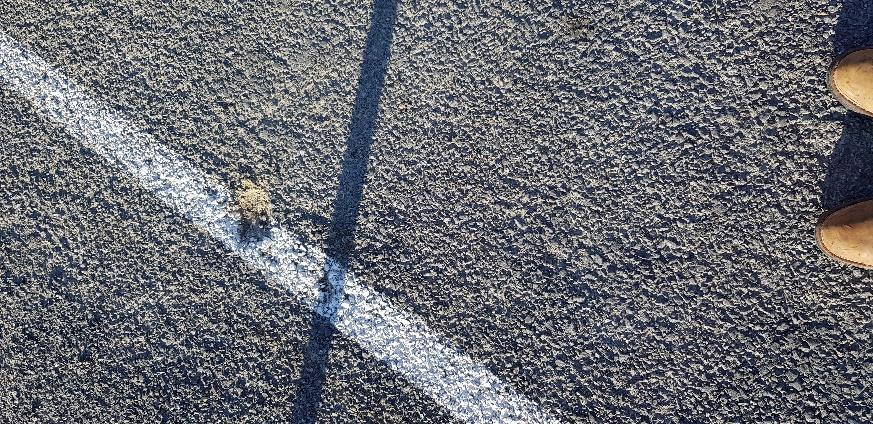
1982
Act
Information
Official
the
under
Released
GHD | Report for New Zealand Transport Agency - Whirokino Trestle and Manawatu River Bridge Replacement Post
Construction Road Safety Audit, 125/09290/00 | 33



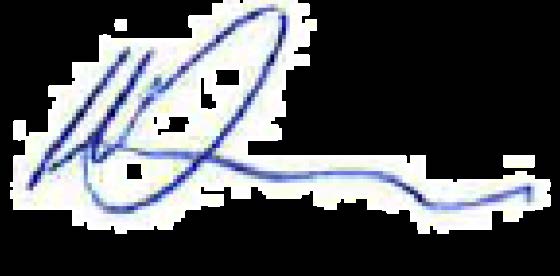
 3.
Audit Statement
3.
Audit Statement
We certif y that we have used the available plans, and have examined the specified roads and
their environment, to identify features of the project we have been asked to look at that could be
changed, removed or modified in order to improve safety. The problems identified have been
noted in this report.
1982
Signed:
Dated:
17 April
2019
Act
s 9(2)(a)
GHD Limited
Signed:
Dated:
17 April
2019
s 9(2)(a)
GHD Limited
Information
Signed:
Dated:
17 April
2019
s 9(2)(a)
GHD Limited
Official
Designer: s 9(2)(a)
Senior Civil Engineer, Bloxam, Burnett & Olliver Ltd
Signed:
Dated:
the
Safety Engineer:
Signed:
Dated:
29 July
under
Out of Scope Team Leader – Saf ety Engineer, New Zealand Transport Agency
Project Manager: Out of Scope Position…Principal Project Manager (NZTA)……..
Released
Signature……………………………………………... Date………………
05/07/21 ….
34 |
GHD | Report for New Zealand Transport Agency - Whirokino Trestle and Manawatu River Bridge Replacement Post
Construction Road Safety Audit, 125/09290/00
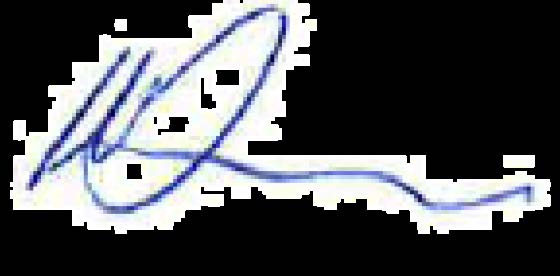
Out of Scope
Project Manager
Action Completed: Name…
………Position………………………..
Signature…………………………………………..….. Date………………………
05/07/21
…….
Project Manager to distribute audit report incorporating decision to designer, Safety
Audit Team Leader, Safety Engineer and project file. Date:…………………
05/07/21
…..
1982
Act
Information
Official
the
under
Released
GHD | Report for New Zealand Transport Agency - Whirokino Trestle and Manawatu River Bridge Replacement Post
Construction Road Safety Audit, 125/09290/00 | 35
1982
Act
Information
Official
the
under
Released

1982
Act
Information
Official
GHD
Level 1, Grant Thornton House
215 Lambton Quay
the
T: 64 4 472 0799 F: 64 4 472 0833 E: [email address]
© GHD Limited 2020
This document is and shall remain the property of GHD. The document may only be used for the
under
purpose for which it was commissioned and in accordance with the Terms of Engagement for the
commission. Unauthorised use of this document in any form whatsoever is prohibited.
https://projects.ghd.com/oc/NewZealand1/whirokinotrestlepost/Delivery/Documents/Whirokino and
Manawatu Bridge Road Safety Audit.docx
Document Status
Rev Author
Reviewer
Approved for Issue
No.
Name
Signature
Name
Signature
Date
1
s 9(2)(a)
17/4/20
Released

1982
Act
Information
www.ghd.com
Official
the
under
Released












































